Quanta Computer 1200015318 Notebook Computer with Built-In Wireless LAN User Manual Solo1200
Quanta Computer Inc Notebook Computer with Built-In Wireless LAN Solo1200
Contents
- 1. User Manual Section 1
- 2. User Masnual section 2
- 3. Mini PCI Card
User Masnual section 2
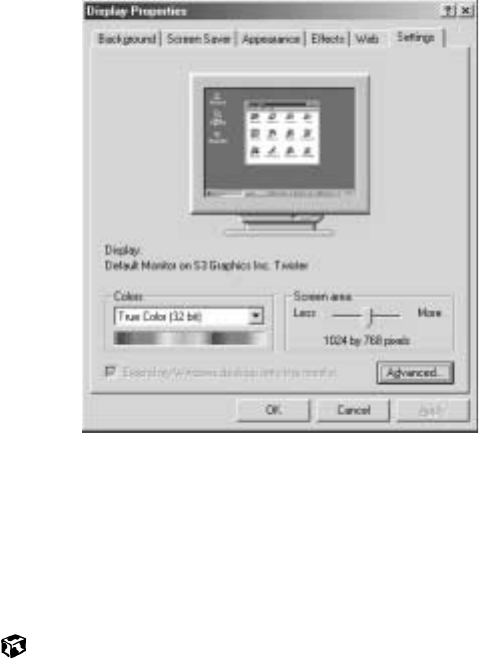
125
Adjusting the screen and desktop settings
www.gateway.com
3Click the Settings tab.
4Select a setting from the Colors list. For most purposes, the color depth
should be 32-bit True Color.
5If you want to save your changes, click OK. Windows tells you it will apply
your changes when you click OK again.
6Click OK.
Solo1200.book Page 125 Friday, May 25, 2001 10:48 AM
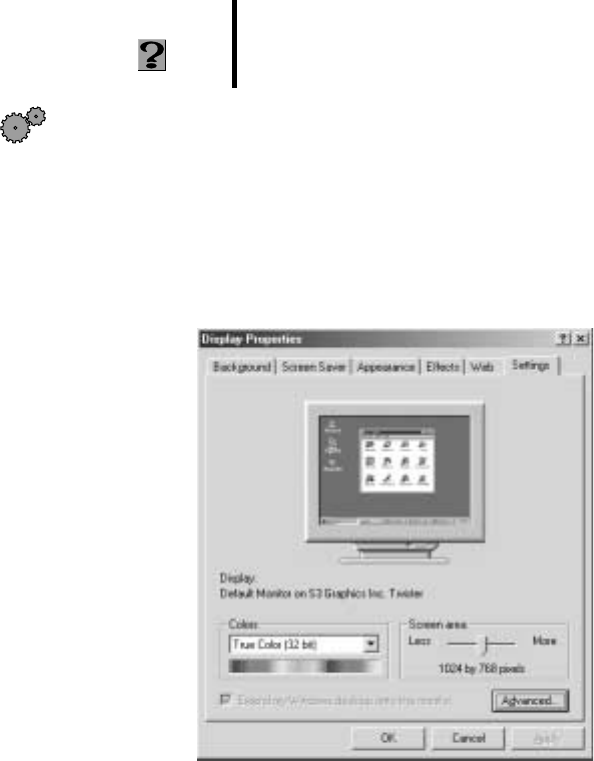
126
Chapter 10: Customizing Your Notebook
www.gateway.com
Adjusting the screen area
You can change the screen area to a size you prefer. For example, you can
increase the screen area to fit more icons on your desktop, or you can decrease
the screen area to make reading and identifying objects on the display easier.
The larger the screen area, the smaller individual components of the screen,
such as icons and menu bars, appear.
To change the screen area:
1Click Start, then select Settings, then Control Panel. The Control Panel
window opens.
2Click/Double-click the Display icon. The Display Properties window
opens.
3Click the Settings tab.
4Drag the Screen area slider to the size you prefer.
HelpSpot For more information on adjusting the screen area,
double-click the HelpSpot icon on your desktop.
Solo1200.book Page 126 Friday, May 25, 2001 10:48 AM
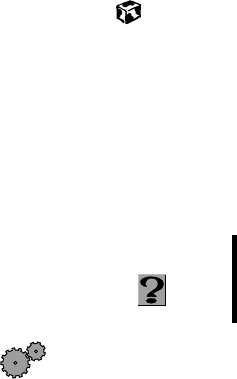
127
Adjusting the screen and desktop settings
www.gateway.com
5If you want to save your changes, click OK. Windows tells you it will apply
your changes when you click OK again.
6Click OK.
Applying a color scheme
A color scheme is a set of colors that you can apply to your Windows
environment. For example, you can change the appearance of such things as
the desktop, windows, and dialog boxes. You can select an existing scheme
or create your own.
To select a color scheme:
1Click Start, then select Settings, then Control Panel. The Control Panel
window opens.
2Click/Double-click the Display icon. The Display Properties window
opens.
HelpSpot For more information on applying a color scheme,
double-click the HelpSpot icon on your desktop.
Solo1200.book Page 127 Friday, May 25, 2001 10:48 AM
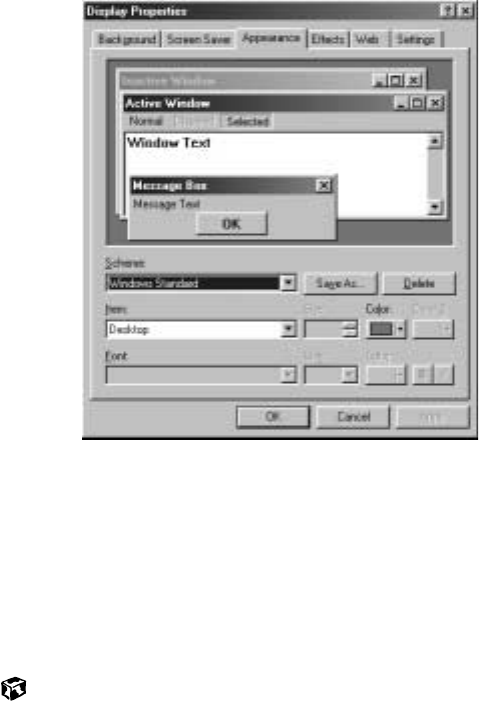
128
Chapter 10: Customizing Your Notebook
www.gateway.com
3Click the Appearance tab. If you want to apply one of Windows’ color
schemes, go to Step 6.
4If you want to create a new scheme, select various items from the Item
list and change their settings.
5Click Save As, type a name for the new scheme, then click OK.
6Select a color scheme from the Scheme list. An example of the scheme
appears in the window above the list.
7Click OK.
Solo1200.book Page 128 Friday, May 25, 2001 10:48 AM
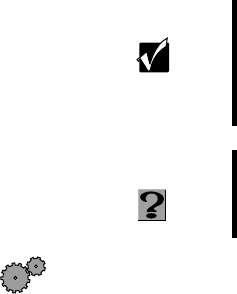
129
Adjusting the screen and desktop settings
www.gateway.com
Changing the desktop background
The Windows desktop background can be changed to either a picture or HTML
document. Windows provides several background pictures. You can also use
pictures or HTML documents that you have created or retrieved from other
sources.
To change the desktop background:
1Click Start, then select Settings, then Control Panel. The Control Panel
window opens.
2Click/Double-click the Display icon. The Display Properties dialog box
opens.
Important If Active Desktop is turned on and you have chosen to
display Web content, the standard desktop background will
be partially or completely hidden, so you may not be able
to see changes you have made in the background. For
more information about Active Desktop, see HelpSpot.
HelpSpot For more information on changing the desktop
background, double-click the HelpSpot icon on your
desktop.
Solo1200.book Page 129 Friday, May 25, 2001 10:48 AM
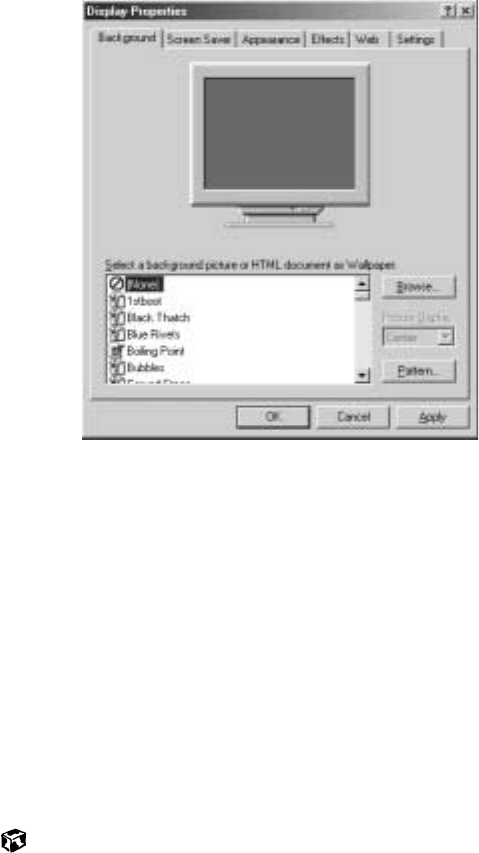
130
Chapter 10: Customizing Your Notebook
www.gateway.com
3Click the Background tab.
4Select a background picture from the Select a background picture or HTML
document as Wallpaper list.
- OR -
Select a background picture from another location by clicking Browse.
5If you want the picture you chose to cover the entire screen, select Tile
from the Picture Display list.
6If the picture you chose does not cover the entire screen and you did
not choose to tile the image in Step 5, you can change the solid color
behind the picture by clicking Pattern, selecting a pattern from the Pattern
list, then clicking OK.
7Click OK.
Solo1200.book Page 130 Friday, May 25, 2001 10:48 AM
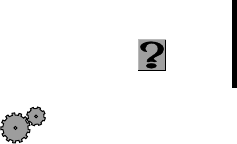
131
Adjusting the screen and desktop settings
www.gateway.com
Selecting a screen saver
You can use a screen saver to keep others from viewing your screen while you
are away from your computer. Windows supplies a variety of screen savers
that you can choose from, and many more are available from the Internet
and as commercial products.
To select a screen saver:
1Click Start, then select Settings, then Control Panel. The Control Panel
window opens.
2Click/Double-click the Display icon. The Display Properties dialog box
opens.
HelpSpot For more information on changing the screen saver,
double-click the HelpSpot icon on your desktop.
Solo1200.book Page 131 Friday, May 25, 2001 10:48 AM
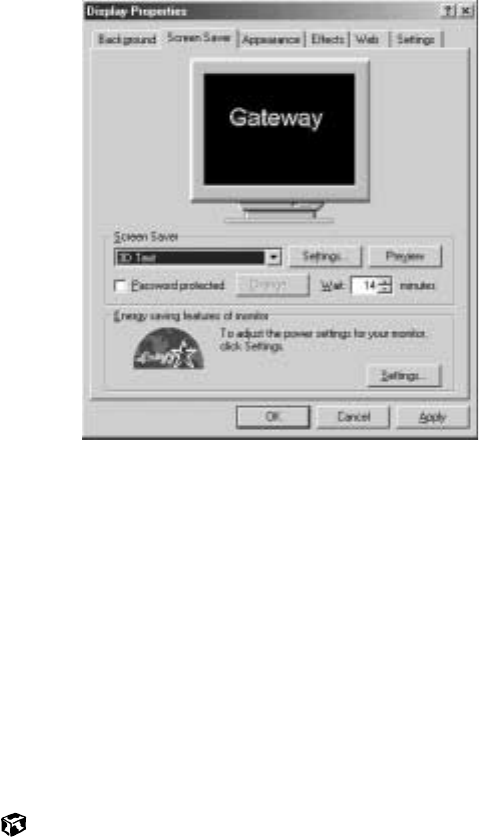
132
Chapter 10: Customizing Your Notebook
www.gateway.com
3Click the Screen Saver tab.
4Select a screen saver from the Screen Saver list. Windows previews the
screen saver.
5If you want to customize the screen saver, click Settings and then make
your changes. If the Settings button is not available, you cannot
customize the screen saver you selected.
6If you want to password protect your screen saver, select the
Password protected checkbox, click Change, type your password, confirm
it, then click OK.
7If you want to change the time before the screen saver is activated, click
the up or down arrows next to the Wait box.
8Click OK.
Solo1200.book Page 132 Friday, May 25, 2001 10:48 AM
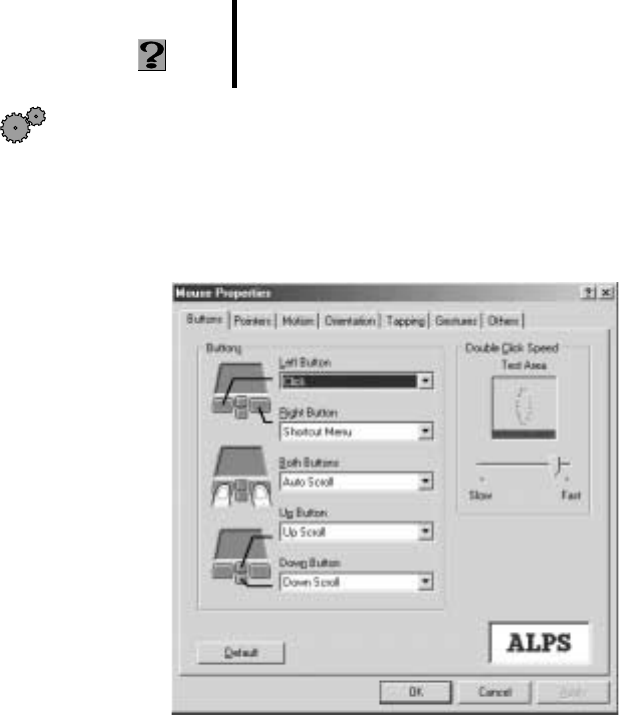
133
Changing the touchpad settings
www.gateway.com
Changing the touchpad settings
You can adjust the double-click speed, pointer speed, left-hand or right-hand
configuration, and other touchpad settings.
To change your touchpad settings:
1Click Start, then select Settings, then Control Panel. The Control Panel
window opens. If you do not see the Mouse icon, click view all Control
Panel options.
2Double-click the Mouse icon. The Mouse Properties dialog box opens.
HelpSpot For more information on changing the touchpad settings,
double-click the HelpSpot icon on your desktop.
Solo1200.book Page 133 Friday, May 25, 2001 10:48 AM

134
Chapter 10: Customizing Your Notebook
www.gateway.com
3Click one of the tabs to change your touchpad settings:
■Buttons lets you change the button configuration and the
double-click speed.
■Pointers lets you customize the appearance of your cursor and
pointer.
■Motion lets you set your pointer speed and pointer trails.
■Orientation lets you change the direction the pointer moves on the
screen.
■Tapping lets you set the tapping speed.
■Gestures lets you assign a function to tapping specific zones on the
touchpad.
■Others lets you select a sound associated with using the Touchpad.
For more information on the touchpad settings, click Help.
4Click OK to save changes.
Solo1200.book Page 134 Friday, May 25, 2001 10:48 AM
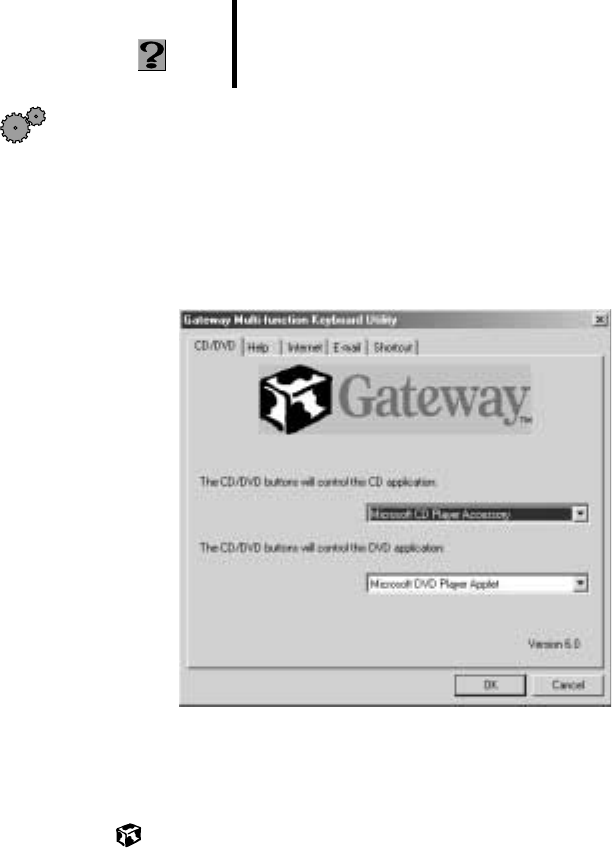
135
Programming the multi-function buttons
www.gateway.com
Programming the multi-function
buttons
The Multi-function Keyboard Utility lets you change the actions of some of
the multi-function buttons.
To program the multi-function buttons:
1Click Start, then select Settings, then Control Panel. The Control Panel
window opens. If you do not see the Multi-function Keyboard icon, click
view all Control Panel options.
2Double-click the Multi-function Keyboard icon. The Gateway
Multi-function Keyboard utility window opens.
3Click the tab corresponding to the multi-function button to make
changes to its function, then click OK. To see which button each tab
corresponds to, see “Multi-function buttons” on page 24.
HelpSpot For more information on programming the multi-function
buttons, double-click the HelpSpot icon on your desktop.
Solo1200.book Page 135 Friday, May 25, 2001 10:48 AM
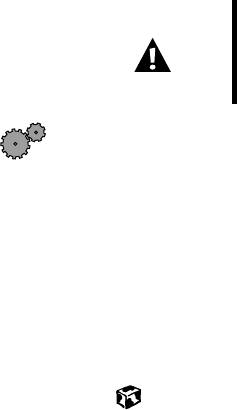
136
Chapter 10: Customizing Your Notebook
www.gateway.com
Allocating system memory
Graphics memory and system memory share the memory installed in your
notebook. By default, the Solo 1200 allocates 8MB of the total memory to
graphics. Some software, such as graphic intensive games, may require you
to allocate more memory to graphics. You can choose to allocate up to 32MB
of the total memory for graphics.
To allocate system memory:
1Restart your notebook. As soon as you see a startup screen, press F2. The
BIOS Setup utility opens.
2Click Advanced, then select Shared memory.
3Select the graphics memory size you want to allocate, then click OK.
4Exit the BIOS Setup utility by clicking Exit, then selecting Save and Exit.
5Click OK.
Caution Increasing the memory allocated to graphics decreases
the system memory. Allocating too much memory to
graphics may adversely affect the performance of your
notebook.
Solo1200.book Page 136 Friday, May 25, 2001 10:48 AM

137
11
www.gateway.com
Upgrading Your
Notebook
This chapter provides information about adding hardware devices to your
notebook. Topics include:
■Adding a PC Card
■Replacing memory
■Replacing the hard drive
Solo1200.book Page 137 Friday, May 25, 2001 10:48 AM
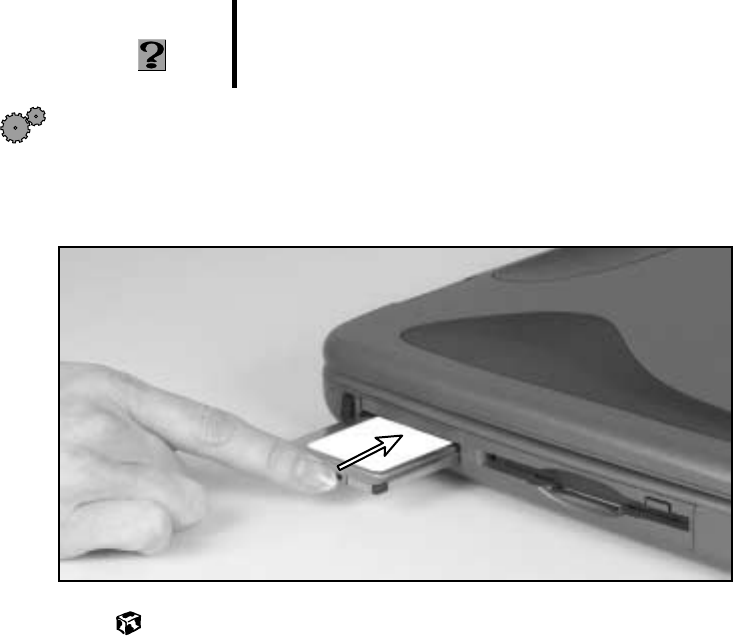
138
Chapter 11: Upgrading Your Notebook
www.gateway.com
Adding a PC Card
Your notebook has a PC Card slot (also known as PCMCIA card slot). This
slot accepts Type I, II, and III cards.
You do not need to restart your notebook when changing most cards because
your notebook supports hot-swapping. Hot-swapping means that you can
insert a PC Card while your notebook is running. If your PC Card does not
work after hot-swapping, refer to the PC Card manufacturer’s documentation
for further information.
To insert a PC Card:
■Push the card firmly into the PC Card slot label-side up until the outer
edge of the card is flush with the side of the notebook.
HelpSpot For more information on adding a PC Card, double-click
the HelpSpot icon on your desktop.
Solo1200.book Page 138 Friday, May 25, 2001 10:48 AM
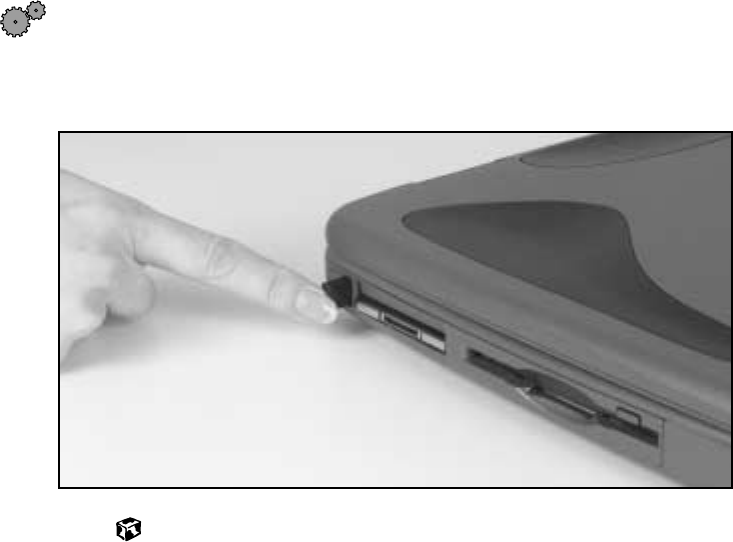
139
Adding a PC Card
www.gateway.com
To remove a PC Card:
1Release the eject button by pressing the PC Card eject button once.
2Eject the PC Card by pressing the eject button again.
Solo1200.book Page 139 Friday, May 25, 2001 10:48 AM

140
Chapter 11: Upgrading Your Notebook
www.gateway.com
Preventing static electricity discharge
The components inside your computer are extremely sensitive to static
electricity, also known as electrostatic discharge (ESD).
Before installing memory or replacing the hard drive, follow these guidelines:
■Turn off the computer power.
■Wear a grounding wrist strap (available at most electronics stores) and
attach it to a bare metal part of the computer.
■Touch a bare metal surface on the back of the computer.
■Unplug the power cord and modem cable.
■Remove the battery pack.
Before working with computer components, follow these guidelines:
■Avoid static-causing surfaces such as carpeted floors, plastic, and packing
foam.
■Remove components from their antistatic bags only when you are ready
to use them. Do not lay components on the outside of antistatic bags
because only the inside of the bags provide electrostatic protection.
■Always hold expansion cards by their edges or their metal mounting
brackets. Avoid touching the edge connectors and components on the
cards. Never slide expansion cards or components over any surface.
Caution ESD can permanently damage electrostatic discharge
sensitive components in the computer. Prevent ESD
damage by following ESD guidelines every time you open
the computer case.
Warning To avoid exposure to dangerous electrical voltages and
moving parts, turn off your computer and unplug the power
cord and modem cable before opening the case.
Warning To prevent risk of electric shock, do not insert any object
into the vent holes of the notebook.
Solo1200.book Page 140 Friday, May 25, 2001 10:48 AM
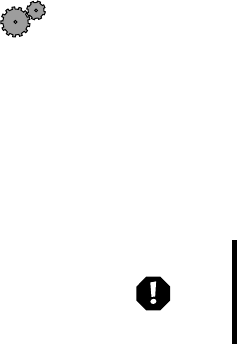
141
Installing memory
www.gateway.com
Installing memory
Your portable computer uses memory modules called SO-DIMMs (Small
Outline Dual Inline Memory Modules). The modules are available in various
capacities and any module can be placed in any available slot. Use PC100 or
PC133 memory modules when upgrading your memory.
To add or replace memory modules:
1Follow the instructions under “Preventing static electricity discharge” on
page 140.
2Shut down the notebook, then disconnect the power cord and modem
cable.
3Turn the notebook over, then remove the main battery. For more
information, see “Changing batteries” on page 109.
Warning Disconnect the power cord, remove the battery, and
disconnect the modem cable before you remove the
memory bay cover. Replace the cover before you restore
power or reconnect the modem cable.
Solo1200.book Page 141 Friday, May 25, 2001 10:48 AM
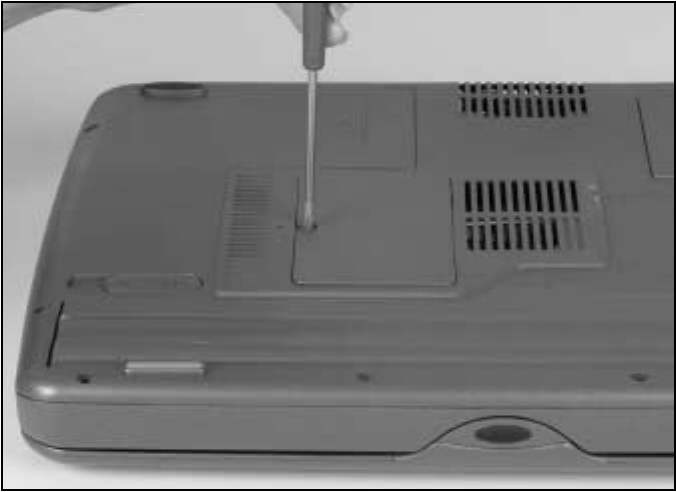
142
Chapter 11: Upgrading Your Notebook
www.gateway.com
4Remove the memory bay cover screw.
5Remove the memory bay cover.
Solo1200.book Page 142 Friday, May 25, 2001 10:48 AM
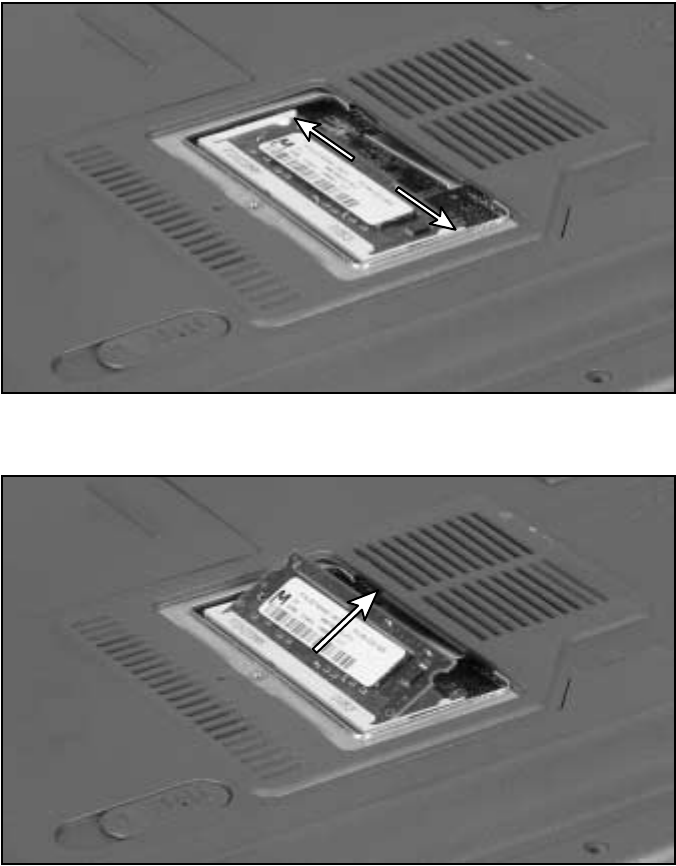
143
Installing memory
www.gateway.com
6Gently press outward on the clips at both ends of the memory module
until the module tilts upward.
7Pull the memory module out of the slot.
Solo1200.book Page 143 Friday, May 25, 2001 10:48 AM
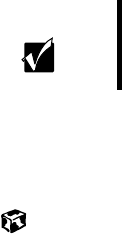
144
Chapter 11: Upgrading Your Notebook
www.gateway.com
8Hold the new or replacement module at a 30-degree angle and press it
into the empty memory slot. This module is keyed so that it can only
be inserted in one direction. If the module does not fit, make sure the
slot in the module lines up with the tab in the memory bay.
9Gently push the module down flat until it clicks in place.
10 Replace the memory bay cover, insert the battery, connect the AC adapter,
and turn on your notebook.
Important Use only PC100 (100 MHz) or PC133 (133 MHz) memory
modules.
Solo1200.book Page 144 Friday, May 25, 2001 10:48 AM
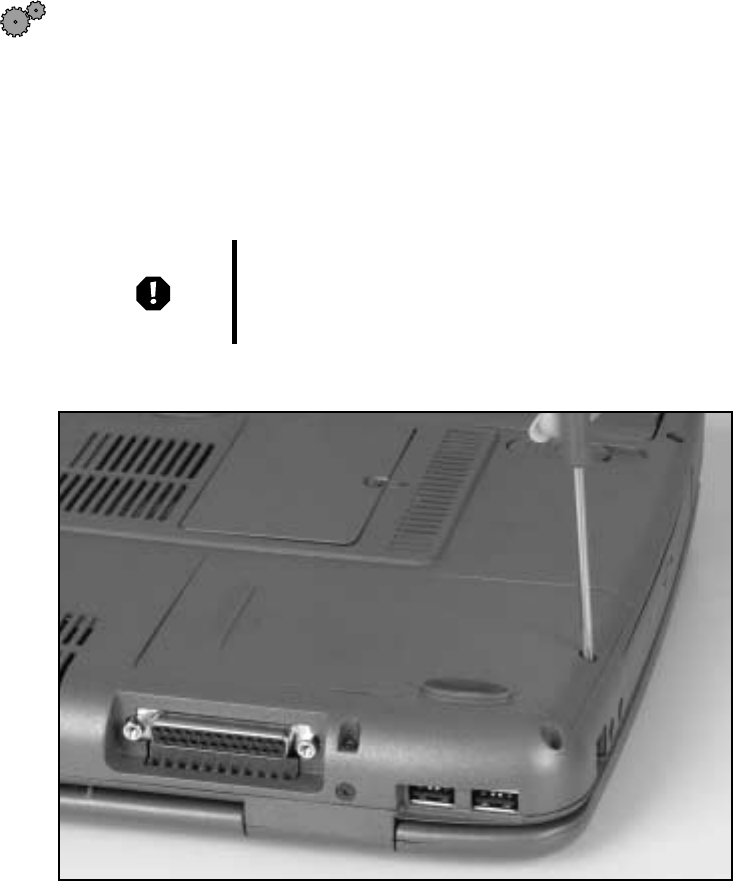
145
Replacing the hard drive
www.gateway.com
Replacing the hard drive
If you would like more hard drive capacity, you can replace your original drive
with a higher-capacity drive.
To replace the hard drive:
1Follow the instructions under “Preventing static electricity discharge” on
page 140.
2Shut down the notebook, then disconnect the AC adapter and modem
cables.
3Turn the notebook over, then remove the main battery. For more
information, see “Changing batteries” on page 109.
4Remove the screw that secures the hard drive to the notebook.
Warning Disconnect the power cord, remove the battery, and
disconnect the modem cable before you remove the hard
drive. Replace the hard drive before you restore power or
reconnect the modem cable.
Solo1200.book Page 145 Friday, May 25, 2001 10:48 AM
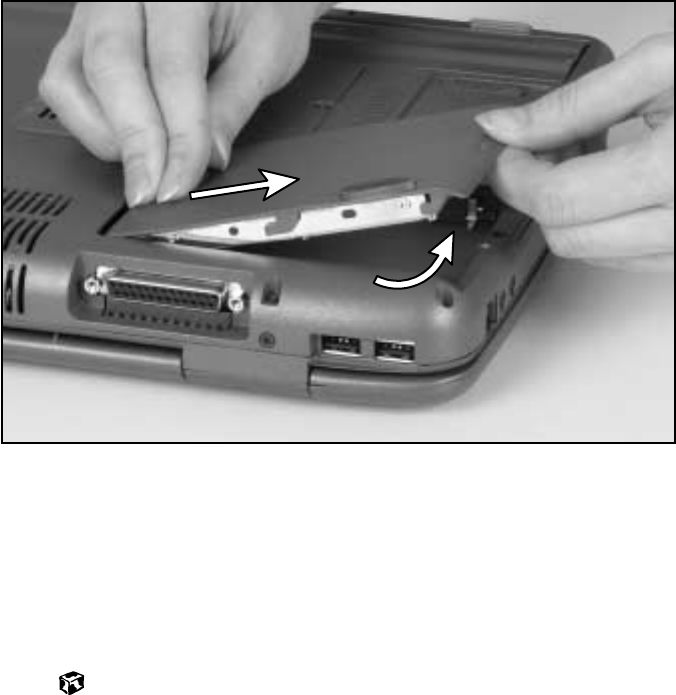
146
Chapter 11: Upgrading Your Notebook
www.gateway.com
5Slide the hard drive kit out.
6Lift the hard drive kit up.
7Place the new hard drive kit onto the notebook case.
8Slide the hard drive kit in.
9Replace the screw to secure the hard drive to the notebook.
10 Reinstall the battery, connect the AC adapter, and turn on your notebook.
Solo1200.book Page 146 Friday, May 25, 2001 10:48 AM

147
12
www.gateway.com
Networking
Your Computer
Connecting your home, small office, or home office computers lets you share
drives, printers, and a single Internet connection among the connected
computers.
This chapter contains information about:
■Benefits of a home, small office, or home office network
■The Gateway Connected Home
■Network connection types
■Your networking shopping list
Solo1200.book Page 147 Friday, May 25, 2001 10:48 AM

148
Chapter 12: Networking Your Computer
www.gateway.com
Using a network
A network lets you:
■Share a single Internet connection
■Share computer drives
■Share peripherals
■Stream audio and video files
■Play multi-player games
Sharing a single Internet connection
A network makes sharing the Internet easy. Each computer or Internet
appliance that is connected to the network can share the same modem and
telephone line or broadband connection and access the Internet at the same
time. This saves on the cost of installing another telephone line for your
second computer and paying for a second Internet Service Provider (ISP)
account.
Sharing drives
With a network, you can copy files from computer to computer by copying
and pasting or dragging and dropping. You will no longer waste your time
transferring files by using diskettes. In addition, you can map a drive from a
computer on the network to a drive on another computer, and access the file
as if it were located on the hard drive of the computer you are using.
Important Most ISPs allow multiple users at the same time.
If you use America Online as your ISP, you can:
■Log onto America Online through one of your screen names
and the other computers can access the Internet using an
Internet browser.
■Upgrade your service to America Online for Home
Networks. This service allows more than one of your screen
names to be online through your home network at one time.
Solo1200.book Page 148 Friday, May 25, 2001 10:48 AM
149
Using a network
www.gateway.com
Sharing peripherals
Each computer that is connected to the network can share the same
peripherals, such as a printer. Select print from the computer you are currently
using and your file is automatically printed on your printer no matter where
it is located on your network.
Streaming audio and video files
With a network, you can store audio files (such as the popular .MP3 files) and
video files on any networked computer, then play them on any of the other
computers or devices connected to your network, a process called streaming.
Add a digital music player such as the Gateway Connected Music Player, and
you can integrate your stereo system into your network as well.
Playing multi-player games
With a home network, you can play multi-player games. Load a game like
Microsoft Midtown Madness 2 on your computers, and in minutes, you and your
friends can race in competing cars through the streets of San Francisco.
Solo1200.book Page 149 Friday, May 25, 2001 10:48 AM
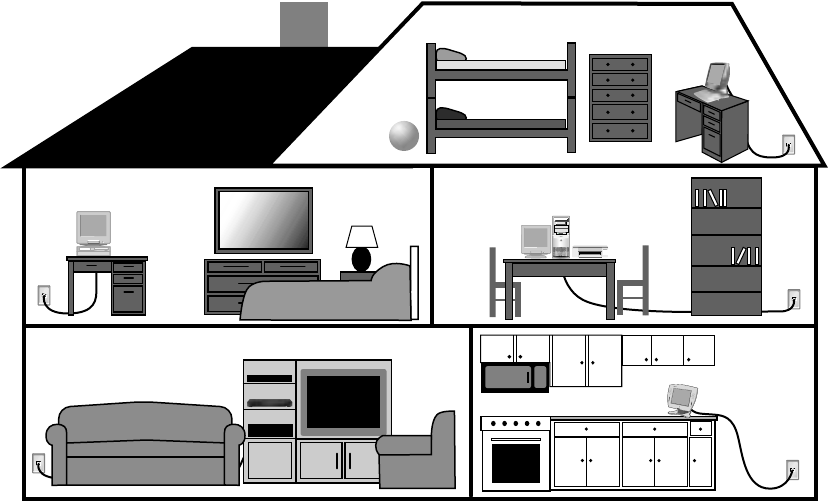
150
Chapter 12: Networking Your Computer
www.gateway.com
Introducing the Gateway Connected
Home
The Gateway Connected Home connects all your computers and other devices
so that you can share files, programs, peripherals, and much more from any
computer in your house. The picture below shows an example Gateway
Connected Home.
Solo1200.book Page 150 Friday, May 25, 2001 10:48 AM
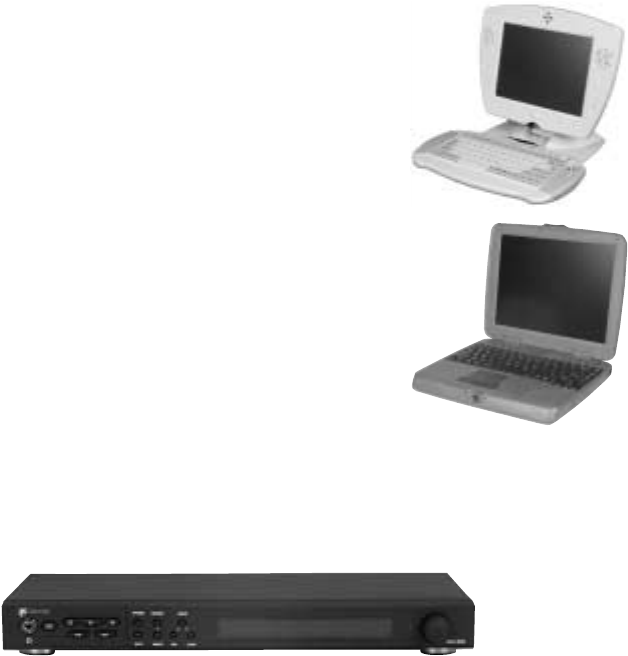
151
Introducing the Gateway Connected Home
www.gateway.com
Components of a Gateway Connected Home
The Gateway Connected Home begins with two computers and a connection.
From there, you can add computers and devices to fit your specific needs. You
can connect:
■Any or all of your connected computers to your Internet connection
simultaneously.
■A Gateway Connected Touchpad to your
connected home so that more than one screen
name can log onto America Online
simultaneously.
■Your notebook computer to your connected
home so you can share files and print at home.
■A Gateway Connected Music Player to your connected home to play
audio files, located on any connected computer, anywhere in your home,
either through your stereo system or through powered speakers.
Solo1200.book Page 151 Friday, May 25, 2001 10:48 AM

152
Chapter 12: Networking Your Computer
www.gateway.com
Selecting a network connection
One of the biggest decisions you will need to make when creating your
network is what type of connection you will use. Gateway supports both wired
and wireless connections.
Wired connections
HPNA (Home Phoneline Networking Alliance) and Ethernet are two popular
types of wired networks.
HPNA
Creating an HPNA network is as easy as knowing where your telephone jacks
and computers are located. HPNA uses your home's standard telephone lines
and telephone jacks instead of special cabling to connect computers. You can
use your networked computers at the same time as you connect to your ISP,
send a fax, or talk on your telephone. For the best performance, your
computers or Internet appliances should have HPNA 2.0 network cards or
jacks for connecting to your network.
Ethernet or Fast Ethernet
Ethernet is a type of connection commonly used in offices around the world.
This type of connection can also be used to build small computer networks
in the home. Ethernet is available at two different speeds: standard Ethernet,
which runs at the same speed as HPNA 2.0, and Fast Ethernet, which runs
up to ten times faster. To create an Ethernet network, you or your electrician
must install special cables in your home or office. Your computers or Internet
appliances must have Ethernet cards or jacks for connecting to a 10 or 10/100
Ethernet switch or hub. If you are connecting just two computers, you can
eliminate the switch or hub and use a special crossover cable.
Important If you have more than one telephone line in your home or
office, make sure that all the computers in your network are
connected to jacks that share the same telephone number.
Important Check local code requirements before installing Ethernet
cable or other wiring in your home or office. Your municipality
may require you to obtain a permit and hire a licensed installer.
Solo1200.book Page 152 Friday, May 25, 2001 10:48 AM

153
Selecting a network connection
www.gateway.com
Broadband Internet connections
You can use your computer’s Ethernet or USB jack for more than just
networking. Many broadband Internet connections, such as cable modems
and DSL modems, connect to your computer’s Ethernet or USB jack. Typically,
if one computer is connected to the Internet, other networked computers also
access the Internet through the shared Internet connection. A broadband,
versus dial-up, connection adds speed and an “always on” connection to your
home network.
Wireless connections
Instead of connecting your computers with wires, you can consider two types
of wireless networks.
Wireless Ethernet
A wireless Ethernet network (also known as IEEE 802.11b or WiFi) exceeds
the speed of either HPNA 2.0 or standard Ethernet. In addition, this type of
network allows you the freedom to move about your home or office with your
computer. For example, you can take your notebook computer from your
home office to your patio without having a telephone or Ethernet jack
available. Although you save on the cost of wiring, the higher cost of wireless
Ethernet equipment may result in a wireless network costing more than a
wired one.
Warning Radio frequency wireless communication can interfere
with equipment on commercial aircraft. Current aviation
regulations require wireless devices to be turned off while
traveling in an airplane. IEEE 802.11b (also known as
wireless Ethernet or Wifi) and Bluetooth communication
devices are examples of devices that provide wireless
communication.
Important If your system came equipped with an internal radio
frequency wireless device, see “Safety, Regulatory, and
Legal Information” on page 215 for general wireless
regulatory and safety guidelines. To find out if your system
has an internal wireless device, check the label (see
“Identifying your model” on page 8.
Solo1200.book Page 153 Friday, May 25, 2001 10:48 AM
154
Chapter 12: Networking Your Computer
www.gateway.com
Bluetooth
Bluetooth is a short-range wireless method for creating a network. Like
wireless Ethernet, Bluetooth allows your computer to send and receive data
without wiring. However, unlike the wireless Ethernet, the range and speed
of the Bluetooth connection are greatly reduced. Bluetooth is an ideal method
for connecting a notebook computer, PDA, pager, cellular telephone, and
printer that are all in close proximity.
Assessing your connection needs
To select the type of network that will work best for you, consider how you
will use your network.
HPNA
An HPNA network is appropriate if:
■Your home, small office, or home office has a telephone jack with the
same telephone number in each room that has a device you want to
connect
■You have several Windows-based computers that are used for drive
sharing, printing to a single printer, or surfing the Internet
■Your notebook computer has one of the following:
■An HPNA jack for connecting to a telephone jack
■A USB port to connect to an HPNA adapter
■Cost savings is more important than network speed
■Your connection speed needs are less than 10000 Kbps (see “Comparing
data transfer speed” on page 157)
Ethernet
An Ethernet or Fast Ethernet network is appropriate if:
■You are building a new home, or your existing home already has Ethernet
cable installed in each room that has a device you want to connect
■You are creating a network in an office or business
■Network speed is more important than cost savings
Solo1200.book Page 154 Friday, May 25, 2001 10:48 AM
155
Selecting a network connection
www.gateway.com
■You have a combination of Windows-based computers and
non-Windows-based computers that are used for drive sharing, printing
to a single printer, or surfing the Internet
■Your notebook computer has an Ethernet jack for connecting to the
network
Solo1200.book Page 155 Friday, May 25, 2001 10:48 AM
156
Chapter 12: Networking Your Computer
www.gateway.com
Wireless Ethernet (IEEE 802.11b, WiFi)
A wireless Ethernet network is appropriate if:
■You are looking for an alternative to using your telephone line or
installing cable for connectivity
■Network speed and the ability to move about with your computer are
more important than cost savings
■You have several Windows-based computers that are used for drive
sharing, printing to a single printer, or surfing the Internet
■Your notebook computer has wireless Ethernet (IEEE 802.11b) for
networking
■Your connection speed needs are less than 11000 Kbps (see “Comparing
data transfer speed” on page 157)
Bluetooth
A Bluetooth network is appropriate if:
■You are looking for an alternative to using your telephone line or
installing cable for connectivity
■Your PDA, pager, cellular telephone, or printer has Bluetooth for
networking
■Your connection needs are less than 1000 Kbps (see “Comparing data
transfer speed” on page 157)
Solo1200.book Page 156 Friday, May 25, 2001 10:48 AM

157
Selecting a network connection
www.gateway.com
Comparing data transfer speed
When deciding between connection types, compare the different data transfer
speeds provided by each to the programs you plan to run on your network.
The following table shows types of programs that you may run in your home
or small office and the connection speed each requires.
The following table shows the Gateway-supported network type and the
maximum speed of each.
Type of Program Speed Required
Voice over IP (VoIP) 5-20 Kbps
Multiplayer Game 20-80 Kbps
Dial-up Internet 24-56 Kbps
MP3 Audio Streaming 80-200 Kbps
Printer Sharing 80-200 Kbps
Broadband Internet 100-1000 Kbps
File Sharing 300-40000 Kbps
MPEG Video Streaming 4000-8000 Kbps
Connection Type Rated Maximum Speed
Bluetooth Wireless 1000 Kbps
HPNA 2.0 Wired 10000 Kbps
Ethernet Wired 10000 Kbps
Wireless Ethernet
(IEEE 802.11b) Wireless 11000 Kbps
Fast Ethernet Wired 100,000 Kbps
Solo1200.book Page 157 Friday, May 25, 2001 10:48 AM
158
Chapter 12: Networking Your Computer
www.gateway.com
When comparing the speed at which your network will need to run to the
speed you can get from the connection type, you should consider which
programs may run at the same time on your network.
For example, you have stored several MP3 audio files on your network. You
typically play music on your Gateway Connected Music Player, and at the
same time your teenager may play music on another computer. Playing two
MP3 audio files simultaneously requires 200 Kbps + 200 Kbps = 400 Kbps. If
at the same time you are playing two MP3 audio files, you also print a file
to your printer, the speed required increases to
200Kbps+200Kbps+200Kbps=600Kbps).
A comparison of the two tables on the previous page shows that HPNA 2.0,
Ethernet, and wireless Ethernet can handle most programs on a network. If
you anticipate using a combination of programs that regularly exceed
10000 Kbps, you should consider installing Fast Ethernet for your connection.
Solo1200.book Page 158 Friday, May 25, 2001 10:48 AM
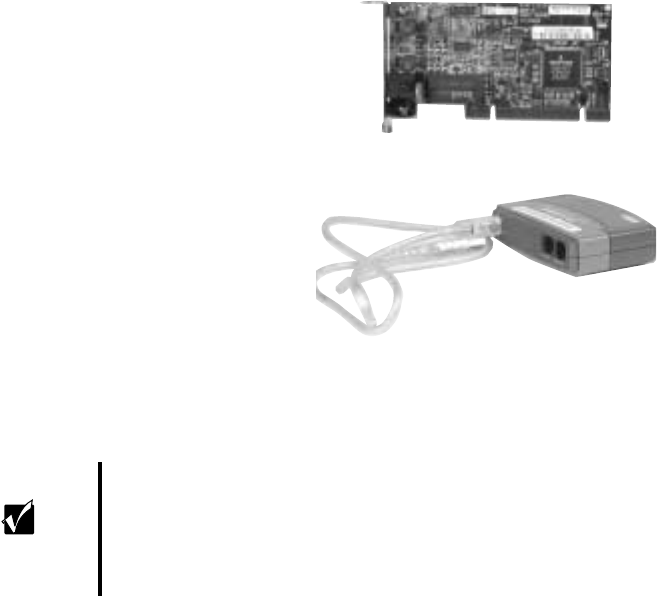
159
Network shopping list
www.gateway.com
Network shopping list
Use the following shopping lists when purchasing equipment for your
network.
HPNA
For an HPNA network you need:
■An HPNA card installed in each
desktop computer
- OR -
An HPNA/V.90 combination card
installed in each desktop computer
- OR -
A USB HPNA adapter attached to
each desktop or notebook
computer
- OR -
A HPNA PC card installed in each notebook computer
■Telephone cord going from each computer to the closest telephone jack
Important Your Gateway computer may already have a factory installed
HPNA/V.90 combination card.
All HPNA components should be HPNA 2.0. A mixture of
HPNA 1.0 and HPNA 2.0 components will result in your
network running at a slower speed.
HPNA card
USB HPNA adapter
Solo1200.book Page 159 Friday, May 25, 2001 10:48 AM
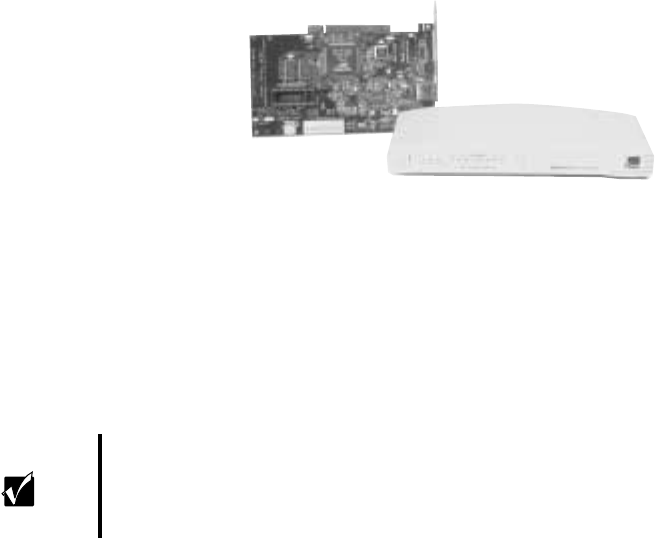
160
Chapter 12: Networking Your Computer
www.gateway.com
Ethernet
For an Ethernet network you need:
■An Ethernet card installed
in each desktop computer
- OR -
An Ethernet jack on each
desktop and notebook
computer
- OR -
An Ethernet PC card installed in each notebook computer
■An Ethernet hub or switch with enough ports for each computer and
device in the network (hubs are slightly cheaper than switches but may
run slower than switches)
■Ethernet cable going from each computer to the hub or switch
Important All Ethernet components should be either standard Ethernet
(10 Mbps) or Fast Ethernet (100 Mbps). A mixture of Ethernet
and Fast Ethernet components will result in your network
running at the slower speed.
Ethernet card and hub
Solo1200.book Page 160 Friday, May 25, 2001 10:48 AM
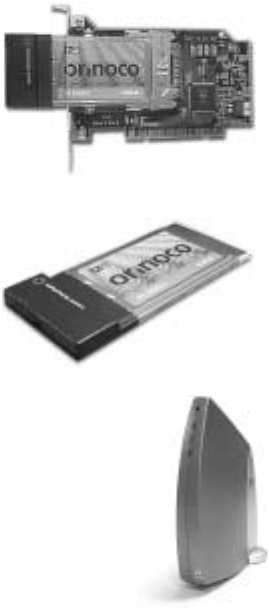
161
Network shopping list
www.gateway.com
Wireless Ethernet
For a wireless Ethernet network you need:
■A wireless Ethernet (IEEE 802.11b) PCI
card installed in each desktop
computer
- OR -
A wireless Ethernet (IEEE 802.11b) PC
card installed in each notebook
computer that does not have wireless
Ethernet built-in
■A wireless Ethernet (IEEE 802.11b)
Access Point if you want to connect
your wireless Ethernet to the Internet
Bluetooth
For a Bluetooth network you need:
■A Bluetooth PCI card installed in each
desktop computer
- OR -
A Bluetooth PC card installed in each
notebook computer that does not have
Bluetooth built-in
■Devices with Bluetooth, such as PDAs,
pagers, cellular telephones, and
printers
Wireless Ethernet PCI card
Wireless Ethernet PC card
Wireless Ethernet Access Point
Solo1200.book Page 161 Friday, May 25, 2001 10:48 AM
162
Chapter 12: Networking Your Computer
www.gateway.com
For more information
For more information about the Gateway Connected Home or networking an
office, discuss your particular needs with your Gateway Country Store
representative. In addition, several books and Internet sites are dedicated to
networking. Refer to these sources for more information about networking
your home or office with HPNA, Ethernet, wireless Ethernet, or Bluetooth.
Solo1200.book Page 162 Friday, May 25, 2001 10:48 AM

163
13
www.gateway.com
Maintaining
Your Notebook
This chapter provides basic information about maintaining your computer
hardware and software.
Caring for your computer
Here are ways to extend the life of your system:
■Be careful not to bump or drop your computer, and do not put any objects
on top of it. The case, although strong, is not made to support extra
weight.
■When transporting your computer, we recommend that you put it in a
carrying case.
■Keep diskettes, modular drives, and your computer away from magnetic
fields. Magnetic fields can erase data on both diskettes and hard drives.
■Never turn off your computer when the hard drive light is on because
data on the hard drive could be lost or corrupted.
■Avoid subjecting your computer to extreme temperature changes. The
case and LCD panel can become very brittle and easy to break in cold
temperatures and can melt or warp in high temperatures. Damage due
to either extreme is not covered by your warranty. As a general rule, your
computer is safest at temperatures that are comfortable for you.
■Keep all liquids away from your computer. Almost any liquid can result
in extremely expensive repairs that are not covered under your warranty.
Solo1200.book Page 163 Friday, May 25, 2001 10:48 AM

164
Chapter 13: Maintaining Your Notebook
www.gateway.com
■Avoid dusty or dirty work environments. Dust and dirt can clog the
internal mechanisms.
■Set up a regular maintenance schedule according to the table below to
keep your computer running at its best.
Maintenance task Immediately
after purchase Monthly When needed See...
Create an emergency diskette X page 165
Check for viruses X X page 167
Manage hard drive space X page 169
Clean up hard drives X X page 170
Scan hard drive for errors X X page 171
Defragment hard drive X X page 173
Back up files X X page 175
Recalibrate the battery X page 177
Clean computer case X page 178
Clean keyboard X page 179
Clean screen X page 179
Clean mouse X page 179
Solo1200.book Page 164 Friday, May 25, 2001 10:48 AM
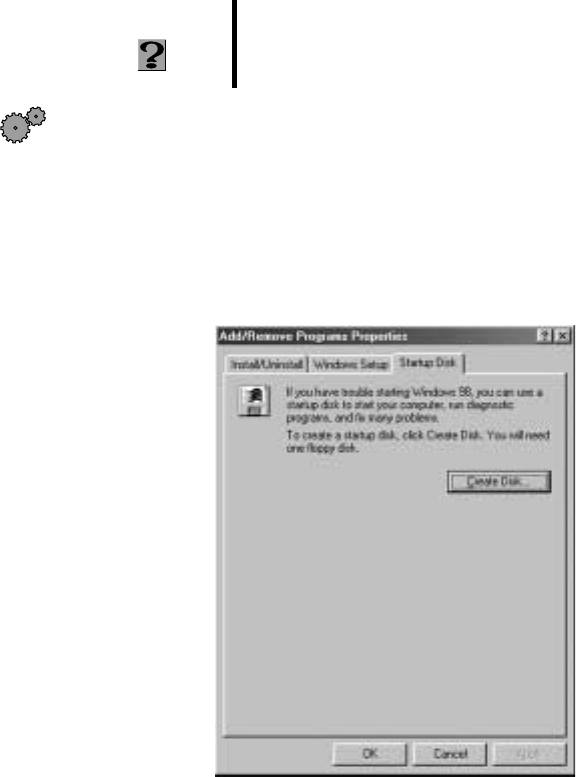
165
Creating an emergency startup diskette
www.gateway.com
Creating an emergency startup
diskette
An emergency startup diskette is a diskette that contains critical information that
you need to start your computer if Windows fails to start. You should create
a startup diskette as soon as you get your computer.
To create an emergency startup diskette:
1Click Start, then select Settings, then Control Panel. The Control Panel
window opens.
2Click/Double-click the Add/Remove Programs icon. The Add/Remove
Programs Properties dialog box opens.
3Click the Startup Disk tab.
HelpSpot For more information on creating an emergency startup
diskette, double-click the HelpSpot icon on your desktop.
Solo1200.book Page 165 Friday, May 25, 2001 10:48 AM
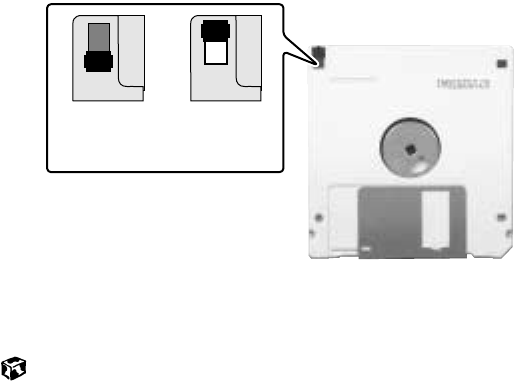
166
Chapter 13: Maintaining Your Notebook
www.gateway.com
4Click Create Disk. A message tells you to label a new diskette and insert
it into the diskette drive.
5Place a new, labeled diskette into the diskette drive.
6Click OK. Windows copies files to the emergency startup diskette.
7When Windows finishes copying files, remove the diskette from the
diskette drive.
8You should write-protect the diskette, which will prevent the diskette
from being erased or infected by viruses, by sliding the tab that is at the
top of the diskette to the up position.
9Store your emergency startup diskette in a safe place with your other
backup software media.
Not write-
protected Write-
protected
Solo1200.book Page 166 Friday, May 25, 2001 10:48 AM
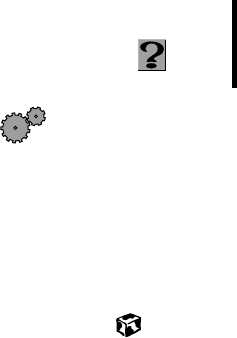
167
Protecting your computer from viruses
www.gateway.com
Protecting your computer from
viruses
A virus is a program that attaches itself to a file on a computer, then spreads
from one computer to another. Viruses can damage data or cause your
computer to malfunction. Some viruses go undetected for a period of time,
because they are activated on a certain date.
Protect your computer from a virus by:
■Using your Norton® AntiVirus program to check files and programs that
are on diskettes, attached to e-mail messages, or downloaded from the
Internet.
■Checking all programs for viruses before installing them.
■Disabling macros on suspicious Microsoft Word and Excel files. These
programs will warn you if a document that you are opening contains a
macro that might have a virus.
To scan for viruses:
1Click Start, then select Programs, Norton AntiVirus, then Norton AntiVirus.
Norton AntiVirus opens.
2Click Scan for Viruses.
3Select the type of scan you want to make in the Scan area, then click
Run Scan Now.
HelpSpot For more information on protecting your computer from
viruses, double-click the HelpSpot icon on your desktop.
Solo1200.book Page 167 Friday, May 25, 2001 10:48 AM

168
Chapter 13: Maintaining Your Notebook
www.gateway.com
To remove a virus:
1Find and remove the virus immediately using Norton AntiVirus.
2Turn off your computer and leave it off for at least 30 seconds.
3Turn on the computer and rescan for the virus.
You should periodically update your Norton AntiVirus program to protect
against the latest viruses.
To update Norton AntiVirus:
1Click Start, then select Programs, Norton AntiVirus, then LiveUpdate - Norton
AntiVirus. The LiveUpdate wizard opens.
2Follow the on-screen instructions to update your Norton AntiVirus
program with the latest virus protection files.
3When the program is done updating, click Finish.
Solo1200.book Page 168 Friday, May 25, 2001 10:48 AM
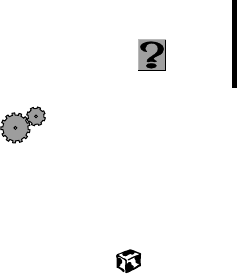
169
Managing hard drive space
www.gateway.com
Managing hard drive space
Windows provides several utilities you can use to manage your hard drive
space and keep your hard drive running efficiently.
Checking hard drive space
In Windows, you can see a chart of the available hard drive space.
To check hard drive space:
1Double-click the My Computer icon. The My Computer window opens.
2Right-click the drive that you want to check for available file space, then
select Properties. Drive space information appears.
HelpSpot For more information on checking hard drive space,
double-click the HelpSpot icon on your desktop.
Solo1200.book Page 169 Friday, May 25, 2001 10:48 AM
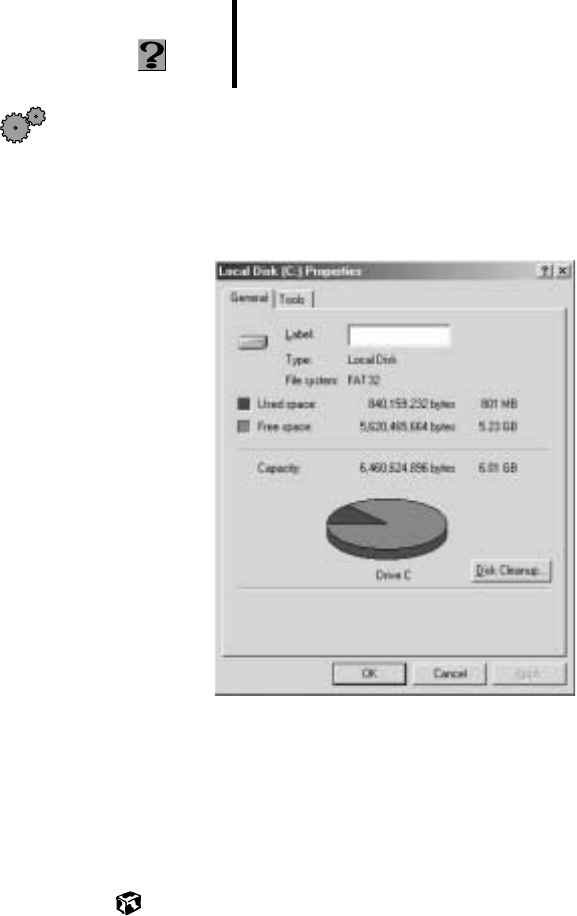
170
Chapter 13: Maintaining Your Notebook
www.gateway.com
Using Disk Cleanup
Delete unneeded files, such as temporary Windows files, to free hard drive
space.
To use Windows Disk Cleanup program:
1Double-click the My Computer icon. The My Computer window opens.
2Right-click the hard drive that you want to delete files from, then select
Properties. The System Properties dialog box opens at the General tab.
3Click Disk Cleanup. The Disk Cleanup dialog box opens.
4Select the check box beside each file type you want to delete. For more
information about file types you can delete, read the descriptions in the
Disk Cleanup dialog box.
5Click OK, then click Yes.
HelpSpot For more information on using Disk Cleanup, double-click
the HelpSpot icon on your desktop.
Solo1200.book Page 170 Friday, May 25, 2001 10:48 AM
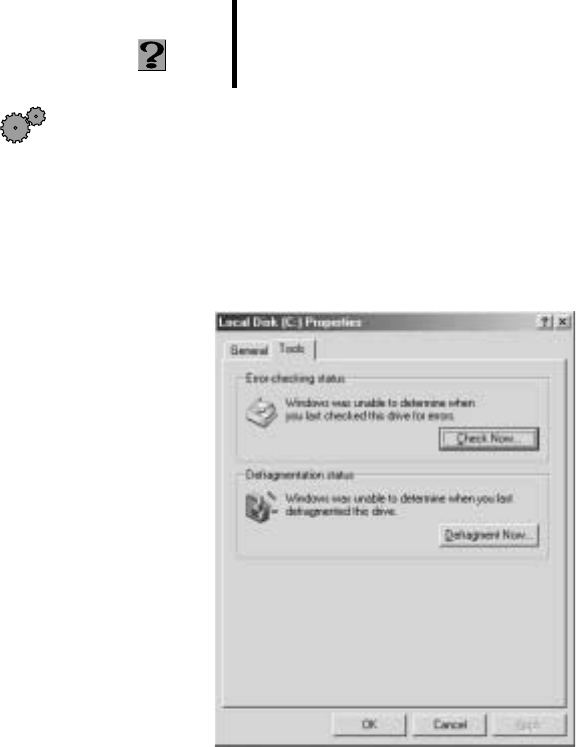
171
Managing hard drive space
www.gateway.com
Scanning the hard drive for errors
The ScanDisk program examines the hard drive for surface errors and file and
folder problems. ScanDisk corrects these problems so that Windows and other
programs run efficiently.
If you use your computer several hours every day, you probably want to run
ScanDisk once a week. On the other hand, if you use your computer less
frequently, once a month may be adequate. Also use ScanDisk if you
encounter hard drive problems.
To run ScanDisk:
1Double-click the My Computer icon. The My Computer window opens.
2Right-click the hard drive that you want to check for errors, then select
Properties. The System Properties dialog box opens.
3Click the Tools tab.
HelpSpot For more information on using ScanDisk, double-click the
HelpSpot icon on your desktop.
Solo1200.book Page 171 Friday, May 25, 2001 10:48 AM

172
Chapter 13: Maintaining Your Notebook
www.gateway.com
4Click Check Now. The ScanDisk dialog box opens.
5Select the options to use, then click Start. For help, press F1. ScanDisk
checks the drive for errors. This process may take several minutes.
6Correct any problems that are found by following the on-screen
instructions. After ScanDisk has finished checking the drive for errors, it
provides a summary of the problems that it found.
7Click Close.
Solo1200.book Page 172 Friday, May 25, 2001 10:48 AM
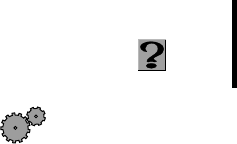
173
Managing hard drive space
www.gateway.com
Defragmenting the hard drive
When working with files, sometimes Windows divides the file information
into pieces and stores them in different places on the hard drive. This is called
fragmentation, and it is normal. In order for the computer to use a file,
Windows must search for the pieces of the file and put them back together.
This process slows the hard drive performance.
The Disk Defragmenter program organizes the data on the drive so that each
file is stored as one unit rather than multiple pieces scattered across different
areas of the drive. Defragmenting the information stored on the drive can
improve hard drive performance.
While the Disk Defragmenter program is running, do not use your keyboard
or mouse because using them may stop and restart the defragmenting process.
Also, if you are connected to a network, log off before starting Disk
Defragmenter. Network communication may stop the defragmentation
process and cause it to start over.
To run Disk Defragmenter:
1Double-click the My Computer icon. The My Computer window opens.
2Right-click the hard drive that you want to defragment, then select
Properties. The System Properties dialog box opens.
HelpSpot For more information on defragmenting your hard drive,
double-click the HelpSpot icon on your desktop.
Solo1200.book Page 173 Friday, May 25, 2001 10:48 AM
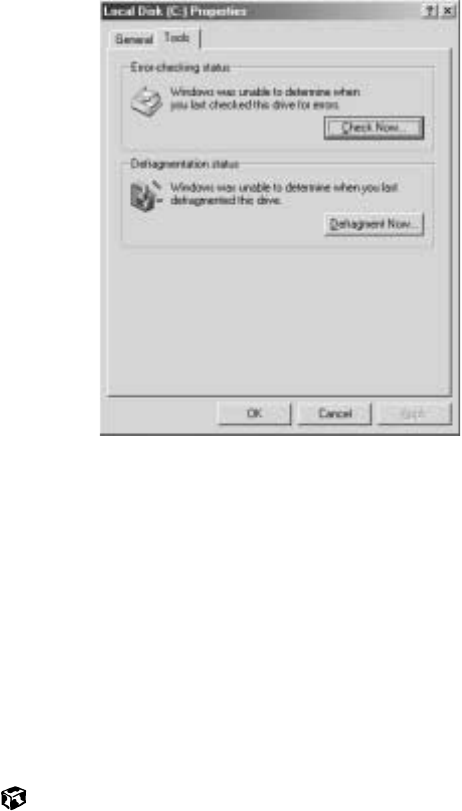
174
Chapter 13: Maintaining Your Notebook
www.gateway.com
3Click the Tools tab.
4Click Defragment Now.
5If Disk Defragmenter does not start automatically, click Start or
Defragment.
Disk Defragmenter shows its progress on the screen. When finished, Disk
Defragmenter asks if you want to quit the program.
6If you want to defragment another drive, click No then follow the
on-screen instructions.
- OR -
If you do not want to defragment another drive, click Yes.
Solo1200.book Page 174 Friday, May 25, 2001 10:48 AM
175
Managing hard drive space
www.gateway.com
Backing up files
Backing up files and removing them from the hard drive frees space for new
files on the hard drive. It also protects you from losing important information
if the hard drive fails or you accidentally delete files.
You should back up your files regularly to diskettes or a writable CD, if you
have a CD-R or CD-RW drive. Use diskettes or writable CDs to do partial
backups of selected files or folders. Use a backup device such as a CD-R,
CD-RW, or Zip drive, or other high-capacity backup device to do a complete
hard drive backup. If you do not have a high-capacity backup device and you
want to purchase one, you can contact Gateway’s Add-on Sales department
or visit our Web site at www.gateway.com.
Solo1200.book Page 175 Friday, May 25, 2001 10:48 AM
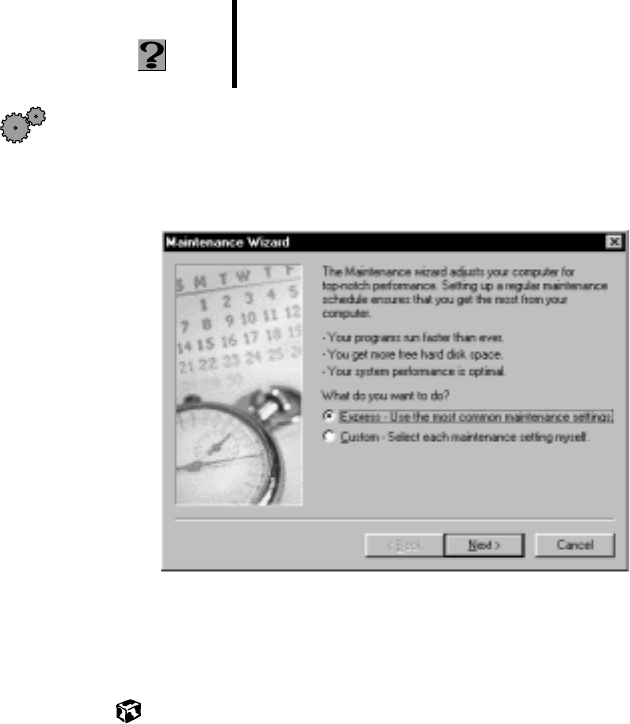
176
Chapter 13: Maintaining Your Notebook
www.gateway.com
Using Maintenance Wizard
The Maintenance Wizard lets you schedule maintenance tasks such as running
Disk Defragmenter and ScanDisk and deleting unnecessary files.
To start the Maintenance Wizard:
1Click Start, then select Programs, Accessories, System Tools, then
Maintenance Wizard. The Maintenance Wizard dialog box opens.
2Select the Maintenance Wizard options that suit your preferences.
Remember that your computer must be on during scheduled
maintenance tasks.
HelpSpot For more information on using the Maintenance Wizard,
double-click the HelpSpot icon on your desktop.
Solo1200.book Page 176 Friday, May 25, 2001 10:48 AM
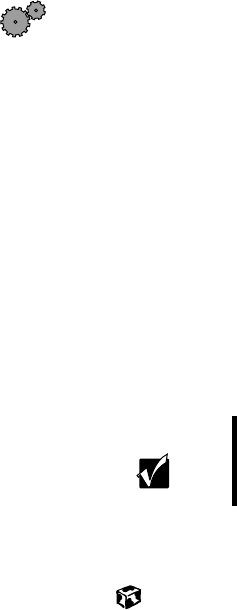
177
Recalibrating the battery
www.gateway.com
Recalibrating the battery
If your notebook unexpectedly goes into Standby mode while you are using
it but the battery charge is not low, you may need to recalibrate your battery.
You should also recalibrate the battery once a year to maintain the accuracy
of the battery gauge.
To recalibrate the battery:
1Connect the AC adapter, then turn on your notebook.
2When you see the startup screen, press F2. The BIOS Setup program
opens.
3Click Exit, then select Battery Auto-Learning (set by default to disabled). A
checkmark appears to show that it is now turned on.
4Exit the BIOS Setup utility by clicking Exit, then selecting Save and Exit.
The battery recalibration program begins and the notebook will reboot.
After your battery has been recalibrated, the notebook recharges the
battery. Recharging may take 12-24 hours. After the battery finishes
recharging, the battery meter displays the accurate battery charge. If the
battery meter does not show an accurate charge, contact Gateway
Technical Support.
5Follow the on-screen instructions to exit the battery recalibration
program.
Important Do not interrupt the battery recalibration process. If
recalibration is interrupted, you must start the process over
again.
Solo1200.book Page 177 Friday, May 25, 2001 10:48 AM
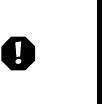
178
Chapter 13: Maintaining Your Notebook
www.gateway.com
Cleaning your computer
Keeping your computer clean and the vents free from dust helps keep your
system performing at its best. You may want to gather these items and put
together a computer cleaning kit:
■A soft cloth
■An aerosol can of air that has a narrow, straw-like extension
■Isopropyl alcohol
■Cotton swabs
■A CD drive cleaning kit
Cleaning the exterior
Always turn off the computer and other peripherals and remove the battery
before cleaning any components.
Use a damp, lint-free cloth to clean the computer and other parts of your
system. Do not use abrasive or solvent cleaners because they can damage the
finish on your components.
Your computer is cooled by air drawn in through the vents on the case, so
keep the vents free of dust. With the computer turned off and unplugged,
brush the dust away from the vents with a damp cloth. Be careful not to drip
any water into the vents. Do not attempt to clean dust from the inside of
the computer.
Warning When you shut down your computer, the power turns off,
but some electrical current still flows through the computer.
To avoid possible injury from electrical shock, unplug the
power cord and modem cable from the wall outlets.
Solo1200.book Page 178 Friday, May 25, 2001 10:48 AM
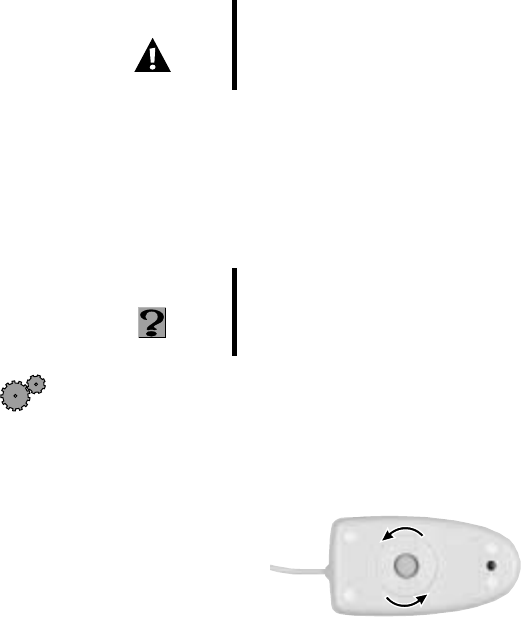
179
Cleaning your computer
www.gateway.com
Cleaning the keyboard
You should clean the keyboard occasionally to free it of dust and lint trapped
under the keys. The easiest way to do this is to blow dirt from under the keys
using an aerosol can of air with a narrow, straw-like extension.
If you spill liquid on the keyboard, turn off the computer and turn the unit
upside down. Let the liquid drain, then let the keyboard dry before trying to
use it again. If the keyboard does not work after it dries, you may need to
replace it.
Cleaning the screen
Use a soft cloth and water to clean the screen. Squirt a little water on the
cloth (never directly on the screen), and wipe the screen with the cloth.
Cleaning the mouse
If you have a mouse and the mouse pointer begins moving erratically across
the screen or becomes difficult to control precisely, then cleaning the mouse
will likely improve its accuracy.
To clean your mouse:
1Turn the mouse upside down.
2Rotate the retaining ring on the bottom of the mouse counter-clockwise.
Caution An LCD screen is made of specially coated glass and can
be scratched or damaged by abrasive or ammonia-based
window cleaners.
HelpSpot For a video demonstration on cleaning the mouse,
double-click the HelpSpot icon on your desktop.
Solo1200.book Page 179 Friday, May 25, 2001 10:48 AM
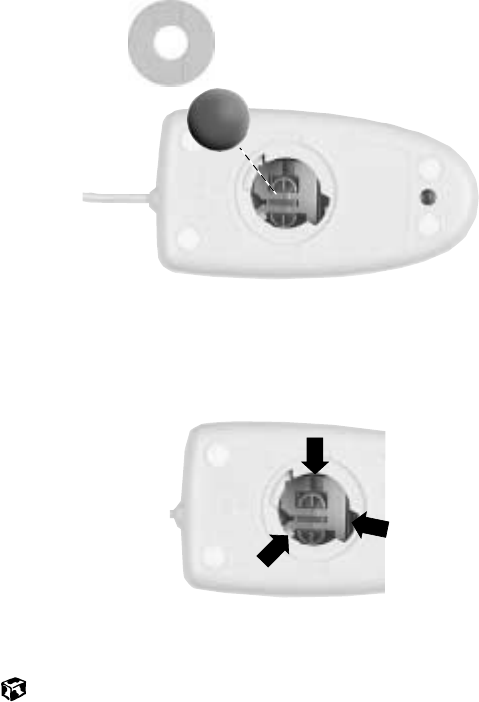
180
Chapter 13: Maintaining Your Notebook
www.gateway.com
3Remove the retaining ring and mouse ball.
4Remove any dust, lint, or dirt from the mouse ball with a soft cloth.
5Clean the mouse rollers with a cotton swab dipped in isopropyl alcohol.
6Replace the mouse ball and lock the retaining ring into place.
Solo1200.book Page 180 Friday, May 25, 2001 10:48 AM

181
14
www.gateway.com
Reinstalling
Device Drivers
Device drivers are programs that control devices such as monitors, CD drives,
and modems. Drivers translate information between computer devices and
programs.
Drivers for your original computer hardware are installed at Gateway. If you
install a new device, you need to install the drivers provided by the device
manufacturer.
You should reinstall device drivers:
■If directed to do so while troubleshooting
■If you see a message indicating that there is a problem with a device driver
This chapter provides instructions for reinstalling device drivers in
Windows Me. If you are not comfortable with the procedures covered in this
chapter, seek help from a more experienced computer user or a computer
service technician.
Solo1200.book Page 181 Friday, May 25, 2001 10:48 AM
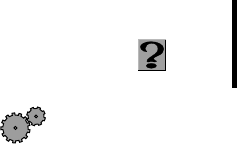
182
Chapter 14: Reinstalling Device Drivers
www.gateway.com
Reinstalling device drivers
If you just reinstalled Windows Me, the device drivers were automatically
reinstalled. However, you need to reinstall device drivers if directed to do so
while troubleshooting or if a message tells you that there is a problem with
a device driver.
To reinstall Windows Me device drivers:
1Place Disc 1 of the System Restoration Kit into your CD drive. The System
Restoration program starts. Go to Step 5.
- OR -
If the program does not start automatically, go to Step 2.
2Click Start, then select Run. The Run dialog box opens.
3In the Open text box, type D:\RUNMENU.EXE (where D is the drive letter
of your CD drive).
4Click OK. The System Restoration Kit program starts.
5If the Welcome to the System Restoration Kit window opens, close it by
clicking OK.
6Click the Reinstall tab.
HelpSpot For more information on reinstalling device drivers,
double-click the HelpSpot icon on your desktop.
Solo1200.book Page 182 Friday, May 25, 2001 10:48 AM

183
Reinstalling device drivers
www.gateway.com
7Click Automatic Installation, then select multiple device drivers to reinstall.
- OR -
Click Manual Installation, then select a single device driver to reinstall.
8Click Install.
9Follow any additional on-screen instructions. Depending on the driver
you are reinstalling, you may only need to restart your computer to
complete the installation. However, if a setup wizard opens when you
restart your computer, follow the on-screen instructions.
Solo1200.book Page 183 Friday, May 25, 2001 10:48 AM
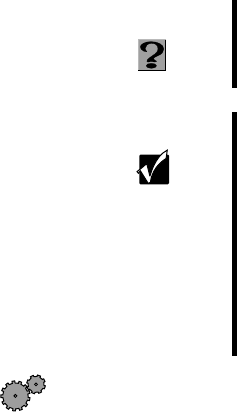
184
Chapter 14: Reinstalling Device Drivers
www.gateway.com
Updating device drivers
The Gateway System Restoration Kit contains a device driver update utility
that works over the Internet. If you do not have an Internet Service Provider,
the update utility works by direct dialing the device driver update service.
To update Windows Me device drivers:
1Place Disc 1 of the System Restoration Kit into your CD drive. The System
Restoration program starts. Go to Step 5.
- OR -
If the program does not start automatically, go to Step 2.
2Click Start, then select Run. The Run dialog box opens.
3In the Open text box, type D:\RUNMENU.EXE (where D is the drive letter
of your CD drive).
4Click OK. The System Restoration Kit program starts.
5If the Welcome to the System Restoration Kit window opens, close it by
clicking OK.
HelpSpot For more information on updating device drivers,
double-click the HelpSpot icon on your desktop.
Important If your system came equipped with a wireless device, only
use the drivers approved for the country the device will be
used in. See the Gateway System Restoration Kit or the
Gateway Technical Support Web site.
If your system came equipped with an internal radio
frequency wireless device, see “Safety, Regulatory, and
Legal Information” on page 215 for general wireless
regulatory and safety guidelines. To find out if your system
has an internal wireless device, check the label (see
“Identifying your model” on page 8.
Solo1200.book Page 184 Friday, May 25, 2001 10:48 AM

185
Updating device drivers
www.gateway.com
6Click the Update tab.
7Click Check Now. The Connect window opens.
8Install available updated device drivers by following the on-screen
instructions. Depending on the driver you are updating, you may only
need to restart your computer to complete the installation. However, if
a setup wizard opens when you restart your computer, follow the
on-screen instructions.
Solo1200.book Page 185 Friday, May 25, 2001 10:48 AM
186
Chapter 14: Reinstalling Device Drivers
www.gateway.com
Solo1200.book Page 186 Friday, May 25, 2001 10:48 AM

187
15
www.gateway.com
Restoring
Software
If your computer is not working properly, try the following options to correct
the problem:
■Reinstall device drivers. For more information, see “Reinstalling Device
Drivers” on page 181.
■Troubleshooting. For more information, see “Troubleshooting” on
page 191.
If the options above do not correct the problem, you can use the System
Restoration Kit to reinstall Windows and other software. Find out more about
the reinstallation options in “Reinstalling Windows Me” on page 188.
Solo1200.book Page 187 Friday, May 25, 2001 10:48 AM
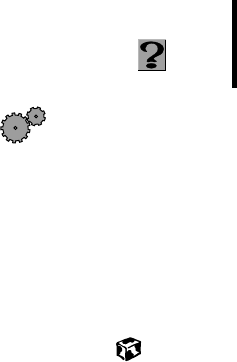
188
Chapter 15: Restoring Software
www.gateway.com
Reinstalling Windows Me
The System Restoration Kit steps you through reinstalling Windows Me. It
automatically reinstalls the hardware device drivers and some software. The
remaining software is installed using the CDs that came with your computer.
To reinstall Windows Me and the device drivers:
1Place Disc 2 of the System Restoration Kit in the CD drive. If you have an
additional recordable/rewritable CD drive, make sure you do not put the
System Restoration CD in it.
2Restart the computer.
3Follow the on-screen instructions. The on-screen instructions step you
through the operating system and device drivers installation.
HelpSpot For more information on reinstalling Windows, double-click
the HelpSpot icon on your desktop.
Solo1200.book Page 188 Friday, May 25, 2001 10:48 AM

189
Reinstalling programs
www.gateway.com
Reinstalling programs
If you have problems running a program or if you have reinstalled your
operating system, you can reinstall programs from the System Restoration Kit
and the program CDs. Follow the installation instructions on each CD.
To reinstall a program from the System Restoration Kit:
1Place Disc 1 of the System Restoration Kit into your CD drive. The System
Restoration program starts. Go to Step 5.
- OR -
If the program does not start automatically, go to Step 2.
2Click Start, then select Run. The Run dialog box opens.
3In the Open text box, type D:\RUNMENU.EXE (where D is the drive letter
of your CD drive).
4Click OK. The System Restoration Kit program starts.
5If the Welcome to the System Restoration Kit window opens, close it by
clicking OK.
6Click the Reinstall tab.
7Click Automatic Installation, then select the program to reinstall.
- OR -
Click Manual Installation, then select the program to reinstall.
8Click Install.
9Follow any additional on-screen instructions. Depending on the program
you are reinstalling, you may only need to restart your computer to
complete the installation. However, if a setup wizard opens when you
restart your computer, follow the on-screen instructions.
HelpSpot For more information on reinstalling programs, double-click
the HelpSpot icon on your desktop.
Solo1200.book Page 189 Friday, May 25, 2001 10:48 AM
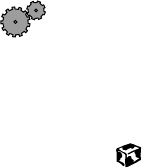
190
Chapter 15: Restoring Software
www.gateway.com
To reinstall a program from a CD:
1Place the program CD in your CD drive.
2Complete the reinstallation by following the instructions included with
the program CD.
Solo1200.book Page 190 Friday, May 25, 2001 10:48 AM

191
16
www.gateway.com
Troubleshooting
This chapter provides some solutions to common computer problems. Use the
information to troubleshoot and correct typical hardware and software issues.
If the suggestions in this chapter do not correct the problem, see “Getting
Help” on page 33 for more information about how to get help.
Safety guidelines
While troubleshooting your computer, follow these safety guidelines:
■Never remove the hard drive or memory bay cover while your computer
is turned on.
■Make sure you are properly grounded before accessing internal
components. For more information about preventing damage from static
electricity, see “Preventing static electricity discharge” on page 140.
Important If your system came equipped with an internal embedded
wireless device, do not operate the wireless device unless
all covers and shields are in place and the system is fully
assembled.
Solo1200.book Page 191 Friday, May 25, 2001 10:48 AM
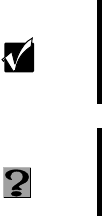
192
Chapter 16: Troubleshooting
www.gateway.com
First steps
If you have problems with your computer, try these things first:
■Make sure that the AC adapter is connected to your computer and an
AC outlet and that the AC outlet is supplying power.
■If you use a power strip or surge protector, make sure it is turned on.
■If a peripheral device does not work, make sure that all connections are
secure.
■Make sure that your hard drive is not full.
■If an error message appears on the screen, write down the exact message.
The message may help Gateway Technical Support in diagnosing and
fixing the problem.
■If you added or removed modules or peripheral devices, review the
installation procedures you performed and make sure you followed each
instruction.
■If an error occurs in a program, consult the printed documentation or
the online help.
Important Do not try to troubleshoot your problem if power cords or
plugs are damaged, if your computer was dropped, or if
the cabinet was damaged. Instead, unplug your computer
and contact a qualified computer technician.
HelpSpot For more information on troubleshooting, double-click the
HelpSpot icon on your desktop.
Solo1200.book Page 192 Friday, May 25, 2001 10:48 AM

193
Software support tools
www.gateway.com
Software support tools
Your system may include PC Doctor to help you diagnose and fix problems.
PC Doctor is a comprehensive hardware diagnostic and system information
tool that can test your computer and determine its configuration. PC Doctor
provides 85 professional diagnostic tests directly from your computer.
PC Doctor is available from HelpSpot or by clicking Start, then selecting
Programs, then Gateway Utilities.
HelpSpot For more information on using PC Doctor, double-click the
HelpSpot icon on your desktop.
Solo1200.book Page 193 Friday, May 25, 2001 10:48 AM
194
Chapter 16: Troubleshooting
www.gateway.com
Troubleshooting
CD drive
The computer does not recognize a disc or the CD drive
■The disc may not be properly seated in the tray. When you place a disc
on the tray, make sure that you press the disc firmly onto the spindle so
that the retaining clips hold the disc in place.
■The CD drive may not be completely inserted into the drive bay. Press
the drive into the bay, then try to access the disc again.
■Make sure the disc label is facing up.
■Try a different disc. Occasionally discs are flawed and cannot be read by
the drive.
■Clean the disc. For more information, see “To clean a CD:” on page 195.
■Your computer may be experiencing some temporary memory problems.
Shut down and restart your computer.
An audio CD does not produce sound
■Make sure the CD label is facing up.
■Click the speaker icon in the lower right corner of the taskbar and make
sure the volume controls are turned up.
■Make sure mute controls are turned off by double-clicking the speaker
icon in the lower right corner of the taskbar and making sure that the
Master Out, CD Audio, MIDI, Digital, and Wave mute check boxes are not
selected. For more information about setting the mute control, see
“Adjusting the volume” on page 85.
■Clean the CD. For more information, see “To clean a CD:” on page 195.
■Your computer may be experiencing some temporary memory problems.
Shut down and restart your computer.
■Reinstall the audio device drivers. For more information, see “Reinstalling
Device Drivers” on page 181.
Solo1200.book Page 194 Friday, May 25, 2001 10:48 AM
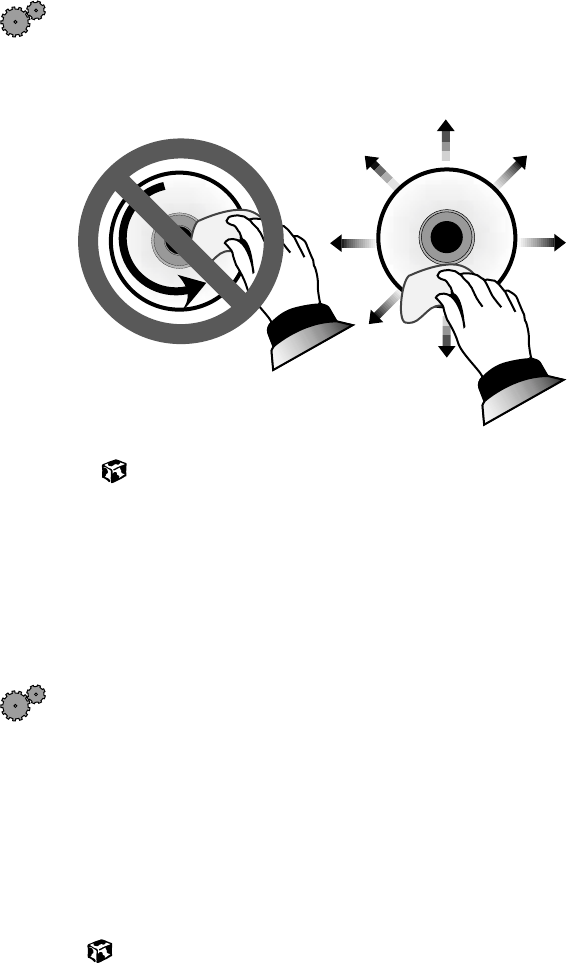
195
Troubleshooting
www.gateway.com
To clean a CD:
■Wipe from the center to the edge, not around in a circle, using a
product made especially for the purpose.
Device installation
You have computer problems after adding a new device
Sometimes a new device, such as a PC Card, can cause a system resource (IRQ)
conflict. Check IRQ usage to determine if there is an IRQ conflict.
To check IRQ usage:
1Click Start, then select Settings, then Control Panel. The Control Panel
window opens. If you do not see the System icon, click view all control
panel options.
2Double-click the System icon, then click the Device Manager tab. The
Device Manager opens.
3Click Computer, then click Properties. The Computer Properties dialog
box opens and displays the IRQs and their hardware assignments.
Solo1200.book Page 195 Friday, May 25, 2001 10:48 AM

196
Chapter 16: Troubleshooting
www.gateway.com
To free IRQ resources for the new device:
1Click Start, then select Settings, then Control Panel. If you do not see
the System icon, click view all control panel options.
2Double-click the System icon, then click the Device Manager tab. The
Device Manager opens.
3Check the device properties for a resource conflict. A resource
conflict appears as a black exclamation point in a yellow circle.
4Remove the device you are trying to install, then determine which
one of your ports you can temporarily turn off. For example, you
could turn off the parallel port.
5In the Device Manager, double-click Ports, click the port you want
to turn off, then click Properties.
6In the Device usage area, click to select the Disabled in this hardware
profile check box, then click OK.
7When you are finished using the device, return to the Device
Manager and turn on the port by clearing the Disabled in this hardware
profile check box.
Diskette drive
The diskette drive is not recognized
■Shut down and restart your computer.
You receive a “Access Denied” or “Write protect” error message
■Move the write-protection tab in the upper-right corner of the diskette
down (unprotected).
■The diskette may be full. Delete unnecessary files on the diskette and try
again.
■Not all diskettes are IBM-compatible. Make sure the diskette you are using
is IBM-compatible.
■Try a different diskette. Occasionally diskettes are flawed and cannot be
read by the diskette drive.
Solo1200.book Page 196 Friday, May 25, 2001 10:48 AM
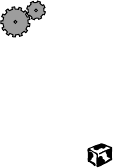
197
Troubleshooting
www.gateway.com
You receive a “Disk is full” error message
■Delete unnecessary files on the diskette.
■Try a different diskette. Occasionally diskettes are flawed and cannot be
read by the diskette drive.
■Run ScanDisk on the diskette. For more information, see “Scanning the
hard drive for errors” on page 171. If errors are detected and corrected,
try using the diskette again.
You receive a “Non-system disk” or “Disk error” error message
■Eject the diskette from the diskette drive, then press ENTER.
■Make sure the diskette you are using is IBM-compatible.
The light on the diskette drive is lit continuously
■Remove the diskette from the drive. If the light stays on, try restarting
your computer.
File management
A file was accidentally deleted
To restore files that were deleted in Windows:
1Double-click the Recycle Bin icon.
2Right-click the file you want to restore, then select Restore. The file
is restored to the place where it was originally deleted from.
Solo1200.book Page 197 Friday, May 25, 2001 10:48 AM

198
Chapter 16: Troubleshooting
www.gateway.com
Hard drive
You receive an “Insufficient disk space” error message
■Delete unnecessary files from the hard drive using Disk Cleanup. For
more information, see “Using Disk Cleanup” on page 170.
■Empty the Recycle Bin by right-clicking the Recycle Bin icon and selecting
Empty Recycle Bin from the pop-up menu.
■If possible, save your files to another disk or drive.
■If the hard drive is full, copy any files not regularly used to diskettes or
other backup media, then delete them from the hard drive.
You receive a “Data error” message
■This may be the result of a defective area on the hard drive. To fix hard
drive problems, run the ScanDisk program. For more information, see
“Scanning the hard drive for errors” on page 171.
The hard drive cannot be accessed, or you receive a “General failure
reading drive C” error message
■If a diskette is in the diskette drive, eject it and restart the computer.
■Make sure that the hard drive is correctly installed. Remove it, firmly
reinsert it, then restart your computer. For more information, see
“Replacing the hard drive” on page 145.
■If your computer has been subjected to static electricity or physical shock,
you may need to reinstall the operating system.
Caution All deleted files will be lost when you empty the
Recycle Bin.
Solo1200.book Page 198 Friday, May 25, 2001 10:48 AM
199
Troubleshooting
www.gateway.com
Internet
You cannot connect to the Internet
■Make sure your computer is connected to the telephone line and the
telephone line has a dial tone. Use the Setup poster to make sure that
the connections have been made correctly.
■If you have the call waiting feature on your telephone line, make sure
it is turned off.
■Make sure your account with your Internet Service Provider (ISP) is set
up properly. Contact your ISP technical support for help.
■Make sure you do not have a problem with your modem. For information
about solving modem problems, see “Modem” on page 201.
You receive an “Unable to locate host” message and are unable to
browse the Internet
This problem can occur when you have typed a URL (Web address) incorrectly,
you have lost your Internet connection, or your ISP is having technical
difficulties.
■Double-check the URL or try a different URL.
■If the error message still appears, disconnect from the ISP connection and
close your browser. Then reconnect and open the browser. If you still get
the error, you may have a problem with your Internet connection or ISP.
Connecting to a Web site takes too long
Many factors can affect Internet performance:
■The condition of the telephone lines in your residence or at your local
telephone company
■The condition of the Internet computers to which you connect and
the number of users accessing those computers
■The complexity of graphics and multimedia on Web pages
■Having multiple Web browsers open, performing multiple downloads,
and having multiple programs open on your computer
Solo1200.book Page 199 Friday, May 25, 2001 10:48 AM
200
Chapter 16: Troubleshooting
www.gateway.com
People are sending you e-mail messages, but you haven’t received
any mail
■Click the receive button in your e-mail program.
■Make sure your account with your Internet Service Provider (ISP) is set
up properly. Contact your ISP technical support for help.
Keyboard
The external keyboard does not work
■Make sure the keyboard cable is plugged in correctly.
■Try a keyboard that you know works to make sure the keyboard port
works.
■If you spilled liquid in the keyboard, turn off the computer and unplug
the keyboard. Clean the keyboard and turn it upside down to drain it.
Let the keyboard dry before using it again.
A keyboard character keeps repeating or you receive a “Keyboard
stuck” or “Key failure” error message
■Make sure that nothing is resting on the keyboard.
■Make sure a key is not stuck. Press each key to loosen a key that might
be stuck, then restart the computer.
LCD panel
The screen area is not correct
■Change the screen area and color depth from the Display Properties
dialog box. For more information, see “Adjusting the color depth” on
page 124 and “Adjusting the screen area” on page 126.
The text on the display is dim or difficult to read
■Adjust the brightness controls.
■Move the computer away from sources of electrical interference such as
televisions, unshielded speakers, microwaves, fluorescent lights, and
metal beams or shelves.
■Change the display settings. For more information, see “Adjusting the
screen and desktop settings” on page 124.
Solo1200.book Page 200 Friday, May 25, 2001 10:48 AM
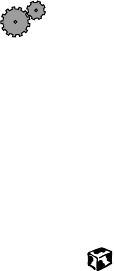
201
Troubleshooting
www.gateway.com
Memory
You receive a “Memory error” message
■Make sure the memory modules are inserted correctly in the memory bay
slot. For more information, see “Installing memory” on page 141.
■Use diagnostic programs to help determine if a memory module is failing.
For more information, see “Installing memory” on page 141.
You receive a “Not enough memory” error message
■Close all programs, then restart the computer.
Modem
Your modem does not dial or does not connect
■Make sure your computer is connected to the telephone line and the
telephone line has a dial tone. Use the Setup poster to make sure that
the connections have been made correctly.
■Make sure that the modem cable is less than 6 feet (1.8 meters) long.
■Remove any line splitters or surge protectors from your telephone line,
then check for a dial tone by plugging a working telephone into the
telephone wall jack.
■If you have additional telephone services such as call waiting, call
messaging, or voice mail, make sure that all messages are cleared and call
waiting is turned off before using the modem. Contact your telephone
service to get the correct code to temporarily turn off the service. Also
make sure the modem dialing properties are set appropriately.
To check the dialing properties:
1Click Start, then select Settings, then Control Panel. The Control Panel
window opens.
2If you do not see the Modems icon, click view all control panel options.
3Double-click the Modems icon, then click Dialing Properties. The
Dialing Properties window opens.
4Make sure all settings are correct.
Solo1200.book Page 201 Friday, May 25, 2001 10:48 AM
202
Chapter 16: Troubleshooting
www.gateway.com
■Disconnect any answering machine, fax machine, or printer that is on
the same line as the modem. You should not have these devices plugged
into the same telephone line as the modem.
■Make sure that you are not using a digital, rollover, or PBX line. These
lines do not work with your modem.
■Check for line noise (scratchy, crackling, or popping sounds). Line noise
is a common problem that can cause the modem to connect at a slower
rate, abort downloads, or even disconnect. The faster the modem, the
less line noise it can tolerate and still work properly.
■Listen to the line using your telephone. Dial a single number (such as 1).
When the dial tone stops, listen for line noise. Wiggle the modem cable
to see if that makes a difference. Make sure the connectors are free from
corrosion and all screws in the wall or telephone wall jack are secure.
■You can also call your telephone service and have them check the
telephone line for noise or low line levels.
■Try another telephone line (either a different telephone number in your
house or a telephone line at a different location). If you can connect on
this line, call your telephone company.
■Try connecting with the modem at a lower connection speed. If reducing
the connect speed lets you connect, contact your telephone company.
The telephone line may be too noisy.
You cannot connect to the Internet
■The ISP may be having technical difficulties. Contact your ISP technical
support for help.
■See if the modem works with a different communications program. The
problem may be with just one program.
Solo1200.book Page 202 Friday, May 25, 2001 10:48 AM
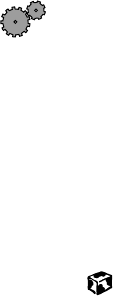
203
Troubleshooting
www.gateway.com
Your 56K modem does not connect at 56K
Current FCC regulations restrict actual data transfer rates over public
telephone lines to 53K. Other factors, such as line noise, telephone service
provider equipment, or ISP limitations, may lower the speed even further.
Upload (sending data out from your computer) speeds are limited to 48K. Your
ISP may not support 48K uploads.
■Check your modem connection speed and dial-up network (DUN)
connections by accessing the gateway.your.way dial-up server. The server
also contains drivers, patches, and updates for current Gateway hardware
and software.
The server provides a secure connection and is a stand-alone server. You
cannot use it to access the Internet. The server cannot be accessed
Mondays from 8:00 a.m. to 12:00 p.m. Central Time, when the server is
backed up.
To access the gateway.your.way dial-up server:
1Insert Disc 1 of the System Restoration Kit.
2Select Help.
3Click Support Web Site, then follow the on-screen instructions.
4To check your modem connection speed, select the Direct Dial option.
After your modem connects, move the mouse cursor over the Dial-Up
Networking icon (located next to the clock on your Taskbar), your
modem connection speed appears.
Your fax communications program only sends and receives faxes at
14,400 bps when you have a 56K modem
Current fax technology only supports a maximum send and receive rate of
14,400 bps.
The modem is not recognized by the computer
■Make sure the line connected to the modem is working and plugged into
the appropriate port on the modem. Use the Setup poster to make sure
that the connections have been made correctly.
■If the modem shares the telephone line with another device, make sure
the telephone line is not in use (for example, someone is on the
telephone, or another modem is in use).
Solo1200.book Page 203 Friday, May 25, 2001 10:48 AM

204
Chapter 16: Troubleshooting
www.gateway.com
■Use the modem cable that came with your computer. Some telephone
cables do not meet required cable standards and may cause problems with
the modem connection.
■Shut down and restart your computer.
■Reinstall the device driver. For more information, see “Reinstalling Device
Drivers” on page 181.
■Run Windows modem diagnostics.
To run modem diagnostics:
1Close all open programs.
2Click Start, then select Settings, then Control Panel. The Control Panel
opens.
3If you do not see the Modems icon, click view all control panel options.
4Double-click the Modems icon. The Modems Properties dialog box
opens.
5Click the Diagnostic tab, click the COM port next to the name of the
modem, then click More Info. The Modem Info dialog box opens.
If information about the modem appears, the modem passed
diagnostics. If no modem information is available, a white screen
appears with no data, or if you get an error such as “port already
open” or “the modem has failed to respond,” the modem did not
pass diagnostics. Contact Gateway Technical Support.
The modem is noisy when it dials and connects
When your modem tries to connect to another modem, it begins handshaking.
Handshaking is a digital “getting acquainted” conversation between the two
modems that establishes connection speeds and communication protocols.
You may hear this communication as unusual sounds when the modems first
connect. If the sounds are too loud, you can turn the modem volume down.
To turn down the modem volume:
1Click Start, then select Settings, then Control Panel. The Control Panel
window appears.
2If you do not see the Modems icon, click view all control panel options.
Solo1200.book Page 204 Friday, May 25, 2001 10:48 AM

205
Troubleshooting
www.gateway.com
3Double-click the Modems icon. The Modems Properties dialog box
appears.
4Click the General tab, select your modem, then click Properties.
5Adjust the Speaker volume control.
6Click OK.
You received an “Unable to establish protocols” error message
■Reinstall dial-up networking and dial-up networking components.
To reinstall dial-up networking:
1Click Start, then select Settings, then Control Panel. The Control Panel
window opens.
2Click/Double-click the Add/Remove Programs icon, then click the
Windows Setup tab.
3Double-click Communications.
4Click to clear the Dial-Up Networking check box, then click OK twice.
The System Settings Change dialog box opens.
5Click Yes. The computer restarts.
6Click Start, then select Settings, then Control Panel. The Control Panel
window opens.
7Click/Double-click the Add/Remove Programs icon, then click the
Windows Setup tab.
8Double-click Communications.
9Click to select the Dial-Up Networking check box, then click OK twice.
The System Settings Change dialog box opens.
10 Click Yes. The computer restarts. If you are asked to insert your
System Restoration Kit CD, do so.
Solo1200.book Page 205 Friday, May 25, 2001 10:48 AM

206
Chapter 16: Troubleshooting
www.gateway.com
To reinstall dial-up networking components:
1Click Start, then select Settings, then Control Panel. The Control Panel
window opens.
2If you do not see the Network icon, click view all control panel options.
3Double-click the Network icon.
4If TCP/IP is not included in the Network Components list, click Add,
then select Protocol, Add, then Microsoft as the manufacturer. Click
TCP/IP on the right side of the dialog box, then click OK.
5Click Client for Netware Networks (if included), then click Remove.
6Click IPX/SPX (if included), then click Remove.
7Click NetBeui (if included), then click Remove.
8Make sure the Primary Network Logon field is set to Windows Logon.
9Click OK twice, then restart the computer.
Mouse
The external mouse does not work
■Make sure that the mouse cable is plugged in correctly.
■Try a mouse you know is working to make sure the mouse port works.
■Shut down and restart your computer.
The external mouse works erratically
■Clean the mouse. For more information, see “Cleaning the mouse” on
page 179.
Networks
You cannot connect to your company network
■Every network is unique. Contact your company computer department
or network administrator for help.
■If your system came equipped with an internal wireless device, do not
operate the wireless device unless the system fully assembled.
Solo1200.book Page 206 Friday, May 25, 2001 10:48 AM
207
Troubleshooting
www.gateway.com
Passwords
The computer does not accept your password
■Make sure that CAPS LOCK and PAD LOCK are turned off, then retype the
password.
You forgot your startup password
■The password feature (which is set in the BIOS Setup utility) is very secure,
with no easy way to recover a forgotten password. You must return your
computer for repair. Call Gateway Technical Support for instructions.
PC Cards
You installed a PC Card and now your computer is having problems
■Make sure that the PC Card you installed is not causing a system resource
conflict. For more information on resource conflicts, see “Device
installation” on page 195.
Power
Your computer is not working on AC power
■Make sure your AC adapter is connected properly to your computer. For
more information, see “Connecting the AC adapter” on page 12.
■If your system is plugged into a surge protector, make sure the surge
protector is securely connected to an electrical outlet, switched on, and
working properly. To test the outlet, plug a working device, such as a
lamp, into the outlet and turn it on.
■Make sure the AC adapter cables are free from cuts or damage. Replace
any damaged cables.
Your computer is not working on battery power
■Make sure the battery is installed properly. For more information, see
“Changing batteries” on page 109.
■Make sure the battery is fully recharged. For more information, see
“Recharging the battery” on page 108.
■Make sure the battery is calibrated correctly. For more information, see
“Recalibrating the battery” on page 177.
Solo1200.book Page 207 Friday, May 25, 2001 10:48 AM
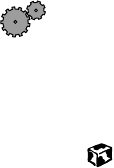
208
Chapter 16: Troubleshooting
www.gateway.com
Printer
The printer will not turn on
■Make sure the power cord is plugged into an AC power source.
The printer is on but will not print
■Check the cable between the printer and the computer. Make sure it is
connected to the proper port.
■Many printers have an online/offline button that you may need to press
so the printer can start printing. Press the button to put the printer
online.
■Check the connector and cable for bent or broken pins.
■Reinstall the printer driver. Use the manual that came with your printer
for instructions on installing the printer driver.
■If the printer you want to print to is not the default printer, make sure
you have selected it in the printer setup.
To set a default printer:
1Click Start, then select Settings, then Printers.
2Right-click on the name of the printer you want to be the default
printer, then select Set as Default.
Solo1200.book Page 208 Friday, May 25, 2001 10:48 AM
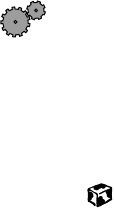
209
Troubleshooting
www.gateway.com
You receive a “Printer queue is full” error message
■Make sure the printer is not set to work offline.
To make sure the printer is not set to work offline:
1Click Start, then select Settings, then Printer.
2Double-click the icon for the printer you want to use.
3Select Printer. If there is a Use Printer Offline option on the menu, click
to clear the check mark.
■Wait until files have been printed before sending additional files to the
printer.
■If you print large files or many files at one time, you may want to add
additional memory to the printer. Consult the printer documentation for
instructions for adding additional memory.
You receive a “Printer is out of paper” error message
■After adding paper, make sure the printer is online. Most printers have
an online/offline button that you need to press after adding paper.
ScanDisk
When you started your computer, it ran ScanDisk
The computer probably had its power interrupted or was improperly shut
down. Windows automatically runs ScanDisk at startup when the computer
was improperly shut down.
ScanDisk fixes errors on the hard drive to minimize data loss. To prevent
ScanDisk from running when you start your computer, make sure you always
shut down by selecting Shut Down from the Start menu.
Solo1200.book Page 209 Friday, May 25, 2001 10:48 AM
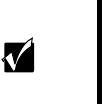
210
Chapter 16: Troubleshooting
www.gateway.com
Sound
You are not getting sound from the speakers
■Make sure the Windows volume control is turned up by clicking the
taskbar speaker icon.
■Make sure that Mute is not selected. For more information, see “Adjusting
the volume” on page 85.
Video
The external monitor is not working
■Make sure that the monitor power is turned on and that the video cable
is properly connected.
The LCD panel has pixels that are always dark or too bright
■This condition is normal and inherent in the TFT technology used in
active-matrix LCD screens. Gateway’s inspection standards keep these to
a minimum. If you feel these pixels are unacceptably numerous or dense
on your display, contact Gateway Technical Support to identify whether
a repair or replacement is justified based on the number of pixels affected.
Important If your computer has a DSTN or HPA LCD panel, you may
notice some minor screen distortions or ghosting with this
technology. Use your contrast Function keys to adjust your
screen for best viewing.
Solo1200.book Page 210 Friday, May 25, 2001 10:48 AM

211
Telephone support
www.gateway.com
Telephone support
Before calling Gateway Technical Support
If you have a technical problem with your computer, follow these
recommendations before contacting Gateway Technical Support:
■Make sure that your computer is connected properly to a grounded
AC outlet that is supplying power. If you use a power strip, make sure
that it is switched on.
■If a peripheral device, such as a keyboard or mouse does not appear to
work, make sure that all cables are plugged in securely.
■If you have recently installed hardware or software, make sure that you
have installed it according to the instructions provided with it. If you
did not purchase the hardware or software from Gateway, refer to the
manufacturer documentation and technical support resources.
■If you have “how to” questions about using a program, consult:
■Online Help
■Printed documentation
■The Microsoft Windows documentation
■The software publisher’s Web site
■Consult the troubleshooting section of this chapter.
■Have your customer ID, serial number, and order number available, along
with a detailed description of your issue, including the exact text of any
error messages, and the steps you have taken.
■Verify that the computer is nearby at the time of your call. The technician
may have you follow appropriate troubleshooting steps while on the line.
Warning To avoid bodily injury, do not attempt to troubleshoot your
computer problem if:
■Power cords or plugs are damaged
■Liquid has been spilled into your computer
■Your computer was dropped
■The cabinet was damaged
Instead, unplug your computer and contact a qualified
computer technician.
Solo1200.book Page 211 Friday, May 25, 2001 10:48 AM

212
Chapter 16: Troubleshooting
www.gateway.com
Telephone numbers
You can access the following services through your telephone to get answers
to your questions:
Resource Service description How to reach
Automated
troubleshooting
system (ATS)
Use an automated menu system and your
telephone keypad to find answers to common
problems.
800-846-2118 (US)
877-709-2945 (Canada)
Fax on demand
support Order a catalog of documents on common
problems, then order documents by document
numbers. The documents will be faxed to you.
800-846-4526 (US)
877-709-2951 (Canada)
Gateway’s
fee-based
software
tutorial service
Get tutorial assistance for software issues billed
by the minute. 800-229-1103 (charged to
your credit card)
900-555-4695 (charged to
your telephone bill)
Gateway
Customer Care Talk to a Gateway Customer Care
representative about a non-tutorial technical
support question. (Refer to “Before calling
Gateway Technical Support” on page 211
before calling.)
TDD Technical Support (for hearing impaired) is
available:
Weekdays 6:00 a.m. - 8:00 p.m. Central Time
Weekends 6:00 a.m. - 5:00 p.m. Central Time
800-846-2301 (US)
800-846-3609 (Canada
and Puerto Rico)
(605) 232-2191 (all other
countries)
(800) 846-1778 (TDD)
America Online Get support for your America Online ISP
account 800-827-6364 (US)
888-265-4357 (Canada)
CompuServe Get support for your CompuServe ISP account 800-848-8990 (US)
Sales,
accounting,
and warranty
Get information about available systems, pricing
orders, billing statements, warranty service, or
other non-technical issues.
800-846-2000 (US)
888-888-2037 (Canada)
Solo1200.book Page 212 Friday, May 25, 2001 10:48 AM
213
Tutoring and training
www.gateway.com
Tutoring and training
Gateway's Technical Support professionals cannot provide hardware and
software training or tutorial services. Instead, Gateway recommends the
following tutoring and training resources.
Self-help
If you have how-to questions about using your Gateway-supplied hardware or
software, consult the following resources:
■The printed or online manual that came with your hardware or software.
In many cases, additional product information and online manuals for
Gateway-supplied hardware can be found in our Web site's
Documentation Library.
■This user guide.
■The software publisher's Web site.
Tutoring
For help on using hardware or software that came with your Gateway
computer, contact Gateway's fee-based tutorial hotline:
■(800) 229-1103 (rate charged per minute; charged to a major credit card.)
■(900) 555-4695 (rate charged per minute; charged to your telephone bill.)
Solo1200.book Page 213 Friday, May 25, 2001 10:48 AM

214
Chapter 16: Troubleshooting
www.gateway.com
Training
Gateway provides the following in-person and computerized training:
Resource Service description For more information
In-Store Training
at Gateway
Country stores
Our friendly and knowledgeable software
trainers can teach you how to use the Internet
and the most popular software programs,
including Microsoft Word, Excel, and
PowerPoint.
www.gateway.com/
about/country/
softwaretraining.shtml
Gateway
Learning
Libraries
A variety of courses and tutorials are available
on CD. Select from several easy-to-use learning
libraries.
www.gateway.com/
software/training/
learning_library.shtml
Online Training
from
Learn@Gateway
More than 450 online courses are available from
Learn@Gateway. All you have to do is go online
and log in. You select the subject matter, and the
learning format (self-paced tutorials or virtual
classrooms), all from the comfort of your
computer.
www.learnatgateway.com/
Solo1200.book Page 214 Friday, May 25, 2001 10:48 AM
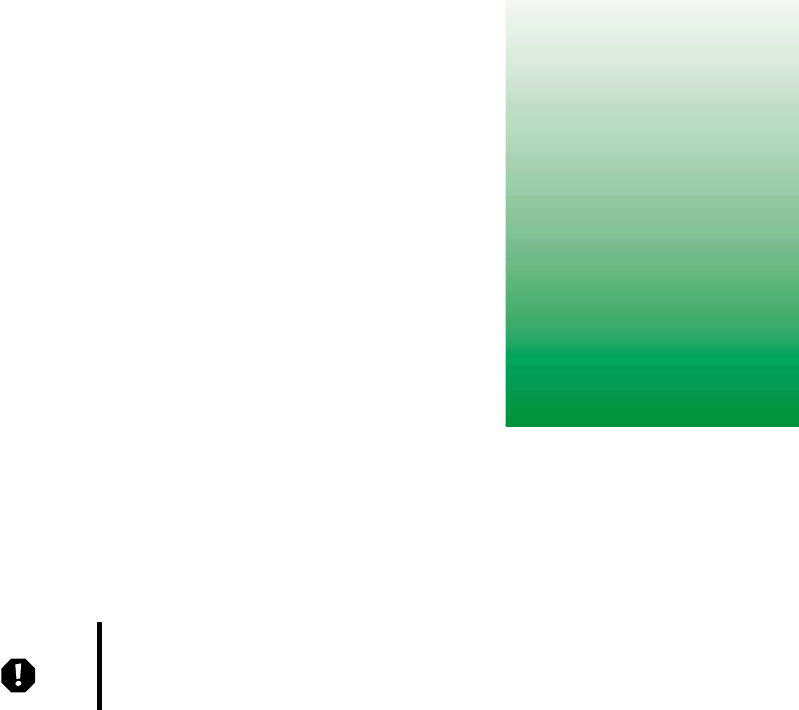
215
A
www.gateway.com
Safety,
Regulatory, and
Legal Information
Important safety information
Your Gateway system is designed and tested to meet the latest standards for safety of information
technology equipment. However, to ensure safe use of this product, it is important that the
safety instructions marked on the product and in the documentation are followed.
Setting up your system
■Read and follow all instructions marked on the product and in the documentation before you
operate your system. Retain all safety and operating instructions for future use.
■Do not use this product near water or a heat source such as a radiator.
■Set up the system on a stable work surface.
■The product should be operated only from the type of power source indicated on the rating
label.
■If your computer has a voltage selector switch, make sure that the switch is in the proper
position for your area. The voltage selector switch is set at the factory to the correct voltage.
■Openings in the computer case are provided for ventilation. Do not block or cover these
openings. Make sure you provide adequate space, at least 6 inches (15 cm), around the system
for ventilation when you set up your work area. Never insert objects of any kind into the
computer ventilation openings.
■Some products are equipped with a three-wire power cord to make sure that the product is
properly grounded when in use. The plug on this cord will fit only into a grounding-type
outlet. This is a safety feature. If you are unable to insert the plug into an outlet, contact an
electrician to install the appropriate outlet.
■If you use an extension cord with this system, make sure that the total ampere rating on the
products plugged into the extension cord does not exceed the extension cord ampere rating.
Warning Always follow these instructions to help guard against
personal injury and damage to your Gateway system.
Solo1200.book Page 215 Friday, May 25, 2001 10:48 AM
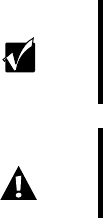
216
Appendix A: Safety, Regulatory, and Legal Information
www.gateway.com
■If your system is fitted with a TV Tuner, cable, or satellite receiver card, make sure that the
antenna or cable system is electrically grounded to provide some protection against voltage
surges and buildup of static charges.
■If your system came equipped with a wireless device, before using, read and follow the
precautions in the regulatory section labeled Wireless guidance and any requirements for the
country in which the system will be use.
Care during use
■Do not walk on the power cord or allow anything to rest on it.
■Do not spill anything on the system. The best way to avoid spills is to avoid eating and
drinking near your system.
■Some products have a replaceable CMOS battery on the system board. There is a danger of
explosion if the CMOS battery is replaced incorrectly. Replace the battery with the same or
equivalent type recommended by the manufacturer. Dispose of batteries according to the
manufacturer’s instructions.
■When the computer is turned off, a small amount of electrical current still flows through the
computer. To avoid electrical shock, always unplug all power cables and modem cables from
the wall outlets before cleaning the system.
■Unplug the system from the wall outlet and refer servicing to qualified personnel if:
■The power cord or plug is damaged.
■Liquid has been spilled into the system.
■The system does not operate properly when the operating instructions are followed.
■The system was dropped or the cabinet is damaged.
■The system performance changes.
Replacement parts and accessories
Use only replacement parts and accessories recommended by Gateway.
Important Do not use Gateway products in areas classified as
hazardous locations. Such areas include patient care
areas of medical and dental facilities, oxygen-laden
environments, or industrial facilities.
Caution To reduce the risk of fire, use only No. 26 AWG or larger
telecommunications line cord.
Solo1200.book Page 216 Friday, May 25, 2001 10:48 AM

217
Regulatory compliance statements
www.gateway.com
Regulatory compliance statements
Wireless guidance
Low power, Radio LAN type devices (radio wave (RF) wireless communication devices), operating
in the 2.4 GHz Band, may be present (embedded) in your notebook system. The following
section is a general overview of considerations while operating a wireless device.
Limitations, cautions, and concerns for specific countries are listed in the specific country
sections (or country group sections). The wireless devices in your system are only qualified for
use in the countries identified by the Radio Approval Marks on the system rating label. If the
country you will be using the wireless device in, is not listed, contact your local Radio Approval
agency for requirements. Wireless devices are closely regulated and use may not be allowed.
The power output of the wireless device or devices that may be embedded in your notebook is
well below the RF exposure limits as known at this time. Because the wireless devices (which may
be embedded into your notebook) emit less energy than is allowed in wireless frequency safety
standards and recommendations, Gateway believes these devices are safe for use. Regardless of
the power levels, care should be taken to minimize human contact during normal operation.
As a general guideline, a separation of 20cm (8 inches) between the wireless device and the body,
for use of a wireless device near the body (this does not include extremities) is typical. This device
should be used more than 20 cm (8 inches) from the body when wireless devices are on.
Some circumstances require restrictions on wireless devices. Examples of common restrictions are
listed below:
Warning Radio frequency wireless communication can interfere
with equipment on commercial aircraft. Current aviation
regulations require wireless devices to be turned off while
traveling in an airplane. IEEE 802.11b (also known as
wireless Ethernet or Wifi) and Bluetooth communication
devices are examples of devices that provide wireless
communication.
Warning In environments where the risk of interference to other
devices or services is harmful or perceived as harmful, the
option to use a wireless device may be restricted or
eliminated. Airports, hospitals, and oxygen or flammable
gas laden atmospheres are limited examples where use
of wireless devices may be restricted or eliminated. When
in environments where you are uncertain of the sanction
to use wireless devices, ask the applicable authority for
authorization prior to using or turning on the wireless
device.
Solo1200.book Page 217 Friday, May 25, 2001 10:48 AM

218
Appendix A: Safety, Regulatory, and Legal Information
www.gateway.com
United States of America
Federal Communications Commission (FCC)
Intentional emitter per FCC Part 15
Low power, Radio LAN type devices (radio wave (RF) wireless communication devices), operating
in the 2.4 GHz Band, may be present (embedded) in your notebook system. This section is only
applicable if these devices are present. Refer to the system label to verify the presence of wireless
devices.
Wireless devices that may be in your system are only qualified for use in the United States of
America if an FCC ID number is on the system label.
The FCC has set a general guideline of 20cm (8 inches) separation between the device and the
body, for use of a wireless device near the body (this does not include extremities). This device
should be used more than 20 cm (8 inches) from the body when wireless devices are on. The
power output of the wireless device (or devices) that may be embedded in your notebook, is well
below the RF exposure limits as set by the FCC.
Unintentional emitter per FCC Part 15
This device has been tested and found to comply with the limits for a Class B digital device,
pursuant to Part 15 of the FCC rules. These limits are designed to provide reasonable protection
against harmful interference in a residential installation. This equipment generates, uses, and
Warning If your system came equipped with an internal embedded
wireless device, do not operate the wireless device unless
all covers and shields are in place and the system is fully
assembled.
Warning Wireless devices are not user serviceable. Contact
Gateway for service.
Warning Wireless devices are not user serviceable. Do not modify
them in any way. Modification to a wireless device will void
the authorization to use it.
Warning Wireless devices are not user serviceable. Contact
Gateway for service.
Warning Wireless devices are not user serviceable. Do not modify
them in any way. Modification to a wireless device will void
the authorization to use it.
Solo1200.book Page 218 Friday, May 25, 2001 10:48 AM

219
Regulatory compliance statements
www.gateway.com
can radiate radio frequency energy and, if not installed and used in accordance with the
instructions, may cause harmful interference to radio or television reception. However, there is
no guarantee that interference will not occur in a particular installation. If this equipment does
cause interference to radio and television reception, which can be determined by turning the
equipment off and on, the user is encouraged to try to correct the interference by one or more of
the following measures:
■Reorient or relocate the receiving antenna
■Increase the separation between the equipment and receiver
■Connect the equipment into an outlet on a circuit different from that to which the receiver is
connected
■Consult the dealer or an experienced radio/TV technician for help.
Compliance Accessories: The accessories associated with this equipment are: shielded video
cable when an external monitor is used. These accessories are required to be used in order to
ensure compliance with FCC rules.
Declaration of conformity
Responsible party:
Gateway Companies, Inc.
610 Gateway Drive, North Sioux City, SD 57049
(605) 232-2000 Fax: (605) 232-2023
Product:
■Solo 1200
This device complies with Part 15 of the FCC Rules. Operation of this product is subject to the
following two conditions: (1) this device may not cause harmful interference, and (2) this device
must accept any interference received, including interference that may cause undesired
operation.
Telecommunications per FCC part 68 (applicable to products fitted with USA
modems)
Your modem complies with Part 68 of the Federal Communications Commission (FCC) rules. On
the computer or modem card is a label that contains the FCC registration number and Ringer
Equivalence Number (REN) for this device. If requested, this information must be provided to the
telephone company.
An FCC-compliant telephone line cord with a modular plug is required for use with this device.
The modem is designed to be connected to the telephone network or premises wiring using a
compatible modular jack which is Part 68-compliant. See installation instructions for details.
The Ringer Equivalence Number (REN) is used to determine the number of devices which may be
connected to the telephone line. Excessive RENs on a telephone line may result in the devices
not ringing in response to an incoming call. In most areas, the sum of RENs should not exceed
five (5.0). To be certain of the number of devices that may be connected to a line, as determined
by the total RENs, contact the local telephone company.
Caution Changes or modifications not expressly approved by
Gateway could void the FCC compliance and negate your
authority to operate the product.
Solo1200.book Page 219 Friday, May 25, 2001 10:48 AM
220
Appendix A: Safety, Regulatory, and Legal Information
www.gateway.com
If this device causes harm to the telephone network, the telephone company will notify you in
advance that temporary discontinuance of service may be required. The telephone company may
request that you disconnect the equipment until the problem is resolved.
The telephone company may make changes in its facilities, equipment, operations, or procedures
that could affect the operation of this equipment. If this happens the telephone company will
provide advance notice in order for you to make necessary modifications to maintain
uninterrupted service.
This equipment cannot be used on telephone company-provided coin service. Connection to
party line service is subject to state tariffs. Contact the state public utility commission or public
service commission for information.
When programming or making test calls to emergency numbers:
■Remain on the line and briefly explain to the dispatcher the reason for the call.
■Perform such activities in the off-peak hours such as early morning or late evenings.
The United States Telephone Consumer Protection Act of 1991 makes it unlawful for any person
to use a computer or other electronic device to send any message via a telephone fax machine
unless such message clearly contains, in a margin at the top or bottom of each transmitted page
or on the first page of the transmission, the date and time it is sent, an identification of the
business, other entity, or other individual sending the message, and the telephone number of the
sending machine or such business, other entity, or individual. Refer to your fax communication
software documentation for details on how to comply with the fax-branding requirement.
Solo1200.book Page 220 Friday, May 25, 2001 10:48 AM

221
Regulatory compliance statements
www.gateway.com
Canada
Industry Canada (IC)
Intentional emitter per RSS 210
Low power, Radio LAN type devices (radio wave (RF) wireless communication devices), operating
in the 2.4 GHz Band, may be present (embedded) in your notebook system. This section is only
applicable if these devices are present. Refer to the system label to verify the presence of wireless
devices.
Wireless devices that may be in your system are only qualified for use in Canada if an Industry
Canada ID number is on the system label.
As a general guideline, a separation of 20cm (8 inches) between the wireless device and the body,
for use of a wireless device near the body (this does not include extremities) is typical. This device
should be used more than 20 cm (8 inches) from the body when wireless devices are on. The
power output of the wireless device (or devices) that may be embedded in your notebook is well
below the RF exposure limits as set by Industry Canada.
Unintentional emitter per ICES-003
This digital apparatus does not exceed the Class B limits for radio noise emissions from digital
apparatus as set out in the radio interference regulations of Industry Canada.
Le présent appareil numérique n’émet pas de bruits radioélectriques dépassant les limites
applicables aux appareils numériques de Classe B prescrites dans le règlement sur le brouillage
radioélectrique édicté par Industrie Canada.
Telecommunications per DOC notice (for products fitted with an IC-compliant
modem)
The Industry Canada label identifies certified equipment. This certification means that the
equipment meets certain telecommunications network protective, operation, and safety
requirements. The Department does not guarantee the equipment will operate to the users’
satisfaction.
Warning To prevent radio interference to licensed service, this
device is intended to be operated indoors and away from
windows to provide maximum shielding. Equipment (or its
transmit antenna) that is installed outdoors is subject to
licensing.
Warning Wireless devices are not user serviceable. Contact
Gateway for service.
Warning Wireless devices are not user serviceable. Do not modify
them in any way. Modification to a wireless device will void
the authorization to use it.
Solo1200.book Page 221 Friday, May 25, 2001 10:48 AM

222
Appendix A: Safety, Regulatory, and Legal Information
www.gateway.com
Before installing this equipment, users should make sure that it is permissible to be connected to
the facilities of the local telecommunications company. The equipment must also be installed
using an acceptable method of connection. In some cases, the inside wiring associated with a
single-line individual service may be extended by means of a certified connector assembly. The
customer should be aware that compliance with the above conditions may not prevent
degradation of service in some situations.
Repairs to certified equipment should be made by an authorized Canadian maintenance facility
designated by the supplier. Any repairs or alterations made by the user to this equipment, or
equipment malfunctions, may give the telecommunications company cause to request the user
to disconnect the equipment.
Users should make sure for their own protection that the electrical ground connections of the
power utility, telephone lines, and internal metallic water pipe system, if present, are connected
together. This precaution may be particularly important in rural areas.
The Ringer Equivalence Number (REN) assigned to each terminal device provides an indication
of the maximum number of terminals allowed to be connected to a telephone interface. The
termination on an interface may consist of any combination of devices subject only to the
requirement that the sum of the Ringer Equivalence Numbers of all the devices does not
exceed 5.
Mexico
Intentional emitter
Low power, Radio LAN type devices (radio wave (RF) wireless communication devices), operating
in the 2.4 GHz Band, may be present (embedded) in your notebook system. This section is only
applicable if these devices are present. Refer to the system label to verify the presence of wireless
devices.
Wireless devices that may be in your system are only qualified for use in Mexico if a NOM mark
is on the system label.
As a general guideline, a separation of 20cm (8 inches) between the wireless device and the body,
for use of a wireless device near the body (this does not include extremities) is typical. This device
should be used more than 20 cm (8 inches) from the body when wireless devices are on. The
power output of the wireless device (or devices) that may be embedded in your notebook is well
below the RF exposure limits as set by NOM.
Warning To avoid electrical shock or equipment malfunction do not
attempt to make electrical ground connections by yourself.
Contact the appropriate inspection authority or an
electrician, as appropriate.
Warning To prevent radio interference to licensed service, this
device is intended to be operated indoors and away from
windows to provide maximum shielding. Equipment (or its
transmit antenna) that is installed outdoors is subject to
licensing.
Solo1200.book Page 222 Friday, May 25, 2001 10:48 AM
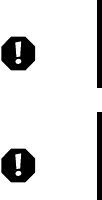
223
Regulatory compliance statements
www.gateway.com
Unintentional emitter
At this time there are no mandatory requirements for Unintentional Emitters, however this
device does comply with multiple requirements for other countries and regions as listed on the
system label and in the users manual.
Warning Wireless devices are not user serviceable. Contact
Gateway for service.
Warning Wireless devices are not user serviceable. Do not modify
them in any way. Modification to a wireless device will void
the authorization to use it.
Solo1200.book Page 223 Friday, May 25, 2001 10:48 AM

224
Appendix A: Safety, Regulatory, and Legal Information
www.gateway.com
European Union
The following information is only applicable to systems labeled with the CE mark .
European directives
This Information Technology Equipment has been tested and found to comply with the
following European directives:
■EMC Directive 89/336/EEC with amending directives 92/31/EEC & 93/68/EEC as per
- EN 55022:1998 Class B
- EN 61000-3-2:1995
- EN 61000-3-3:1995
- EN 55024:1998
■Low Voltage Directive (Safety) 73/23/EEC as per
- EN 60950:1992(A1/A2/A3/A4/A11)
■Radio and Telecom Terminal Equipment Directive 199/5/EC as per
- CTR21:1998 (If fitted with a modem device)
- ETS 300 328-2:2000 (If fitted with a 2.4 GHz band embedded wireless device)
- ETS 301 489-1:2000 (If fitted with a 2.4 GHz band embedded wireless device)
- ETS 301 489-17:2000 (If fitted with a 2.4 GHz band embedded wireless device)
European radio approval information (for products fitted with EU-approved radio
devices)
This Product is a Notebook computer; low power, Radio LAN type devices (radio wave (RF)
wireless communication devices), operating in the 2.4 GHz band, may be present (embedded) in
your notebook system which is intended for home or office use. This section is only applicable if
these devices are present. Refer to the system label to verify the presence of wireless devices.
Wireless devices that may be in your system are only qualified for use in the European Union or
associated areas if a CE mark with a Notified Body Registration Number and the Alert Symbol is
on the system label.
The power output of the wireless device or devices that may be embedded in your notebook is
well below the RF exposure limits as set by the European Commission through the R&TTE
directive.
Solo1200.book Page 224 Friday, May 25, 2001 10:48 AM
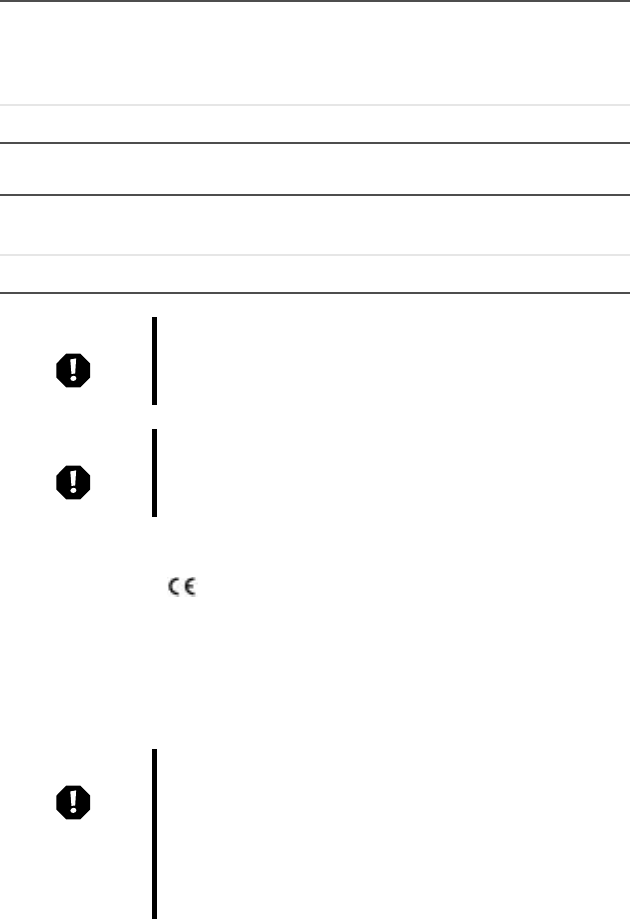
225
Regulatory compliance statements
www.gateway.com
European States qualified under radio approvals:
European States with restrictions on use:
European telecommunication information (for products fitted with EU-approved
modems)
Marking by the symbol indicates compliance of this equipment to the Radio and Telecom
Terminal Equipment Directive 199/5/EC. Such marking is indicative that this equipment meets
or exceeds the following technical standards:
CTR 21 (1998) - Attachment requirements for pan-European approval for connection to the
analogue Public Switched Telephone Networks (PSTNs) of TE (excluding TE supporting voice
telephony services) in which network addressing, if provided, is by means of Dual Tone
Multi-Frequency (DTMF) signaling.
This equipment has been approved to Council Decision 98/482/EEC—“CTR 21” for
Pan-European single terminal connection to the Public Switched Telephone Network (PSTN).
However, due to differences between the individual PSTNs provided in different countries, the
EU Austria, Belgium, Denmark, Finland, France (with
frequency restrictions), Germany, Greece, Ireland, Italy,
Luxembourg, The Netherlands, Portugal, Spain, Sweden
and the United Kingdom.
Accept EU Iceland, Liechtenstein, Norway and Switzerland
EU France only allows operation on channels 10, 11, 12, &
13 (The frequency range 2446-2483.5 MHz)
Accept EU No limitations at this time.
Warning Wireless devices are not user serviceable. Contact
Gateway for service.
Warning Wireless devices are not user serviceable. Do not modify
them in any way. Modification to a wireless device will void
the authorization to use it.
Warning Although this equipment can use either loop disconnect
(pulse) or DTMF (tone) signaling, only the performance of
the DTMF signaling is subject to regulatory requirements
for correct operation. It is therefore strongly recommended
that the equipment is set to use DTMF signaling for access
to public or private emergency services. DTMF signaling
also provides faster call setup.
Solo1200.book Page 225 Friday, May 25, 2001 10:48 AM
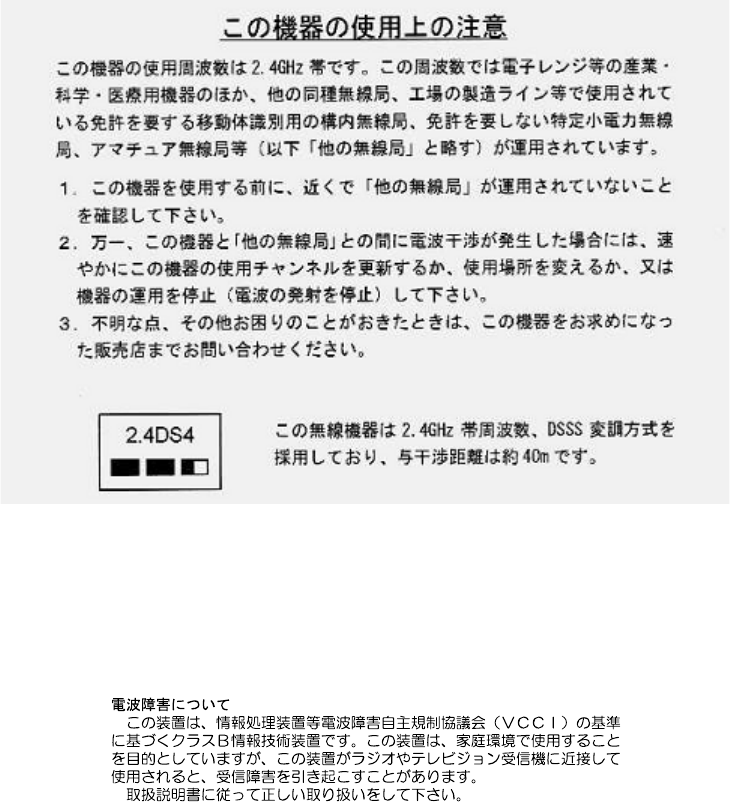
226
Appendix A: Safety, Regulatory, and Legal Information
www.gateway.com
approval does not, of itself, give an unconditional assurance of successful operation on every
PSTN termination point. In the event of problems, you should contact Gateway customer
support.
Japan
Wireless devices
VCCI statement
This equipment is in the Class B category (Information Technology Equipment to be used in a
residential area or an adjacent area thereto) and conforms to the standards set by the Voluntary
Control Council for Interference by Information Technology Equipment aimed at preventing
radio interference in such residential areas. When used near a radio or TV receiver, it may
become the cause of radio interference. Read instructions for correct handling.
Solo1200.book Page 226 Friday, May 25, 2001 10:48 AM

227
Regulatory compliance statements
www.gateway.com
Australia and New Zealand
Wireless devices
Low power, Radio LAN type devices (radio wave (RF) wireless communication devices), operating
in the 2.4 GHz Band, may be present (embedded) in your notebook system. This section is only
applicable if these devices are present. Refer to the system label to verify the presence of wireless
devices.
Wireless devices that may be in your system are only qualified for use in Australia and New
Zealand if a C-tick mark is on the system label.
The power output of the wireless device or devices that may be embedded in your notebook is
well below the RF exposure limits as set by the Australia Communications Authority (ACA) and
Radio Spectrum management Group (RSMG).
EMI statement
This device has been tested and found to comply with the limits for a Class B digital device,
pursuant to the Australian/New Zealand standard AS/NZS 3548 set out by the Australian
Communications Authority and the Radio Spectrum Management Agency.
New Zealand telecommunication statement (for products fitted with
Telepermit-approved modems)
The grant of a Telepermit for any item of terminal equipment indicates only that Telecom has
accepted that the item complies with minimum conditions for connection to its network. It
indicates no endorsement of the product by Telecom, nor does it provide any sort of warranty.
Above all, it provides no assurance that any item will work correctly in all respects with another
item of Telepermitted equipment of a different make or model, nor does it imply that any
product is compatible with all of Telecom's network services.
This equipment shall not be set up to make automatic calls to the Telecom ‘111’ Emergency
Service.
Some parameters required for compliance with Telecom’s Telepermit requirements are dependent
on the equipment (PC) associated with this device. The associated equipment shall be set to
operate within the following limits for compliance with Telecom’s specifications:
Warning Wireless devices are not user serviceable. Contact
Gateway for service.
Warning Wireless devices are not user serviceable. Do not modify
them in any way. Modification to a wireless device will void
the authorization to use it.
Important Under power failure conditions, this telephone may not
operate. Make sure that a separate telephone, not
dependent on local power, is available for emergency use.
Solo1200.book Page 227 Friday, May 25, 2001 10:48 AM
228
Appendix A: Safety, Regulatory, and Legal Information
www.gateway.com
(a)There shall be no more than 10 calls to the same number within any 30-minute period for any
single manual call initiation, and
(b)The equipment shall go on-hook for a period of not less than 30 seconds between the end of
one attempt and the beginning of the next attempt.
The equipment shall be set to make sure that automatic calls to different numbers are spaced
such that there is no less than 5 seconds between the end of one call attempt and the beginning
of another.
The equipment shall be set to make sure that calls are answered between 3 and 30 seconds of
receipt of ringing.
Solo1200.book Page 228 Friday, May 25, 2001 10:48 AM
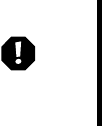
229
Laser safety statement
www.gateway.com
Laser safety statement
All Gateway systems equipped with CD and DVD drives comply with the appropriate safety
standards, including IEC 825. The laser devices in these components are classified as “Class 1
Laser Products” under a US Department of Health and Human Services (DHHS) Radiation
Performance Standard. Should the unit ever need servicing, contact an authorized service
location.
Warning Use of controls or adjustments or performance of
procedures other than those specified in this manual may
result in hazardous radiation exposure. To prevent
exposure to laser beams, do not try to open the enclosure
of a CD or DVD drive.
Solo1200.book Page 229 Friday, May 25, 2001 10:48 AM
230
Appendix A: Safety, Regulatory, and Legal Information
www.gateway.com
Notices
Copyright © 2001 Gateway, Inc.
All Rights Reserved
4545 Town Centre Court
San Diego, CA 92121 USA
All Rights Reserved
This publication is protected by copyright and all rights are reserved. No part of it may be reproduced or
transmitted by any means or in any form, without prior consent in writing from Gateway.
The information in this manual has been carefully checked and is believed to be accurate. However, changes are
made periodically. These changes are incorporated in newer publication editions. Gateway may improve and/or
change products described in this publication at any time. Due to continuing system improvements, Gateway is
not responsible for inaccurate information which may appear in this manual. For the latest product updates,
consult the Gateway Web site at www.gateway.com. In no event will Gateway be liable for direct, indirect, special,
exemplary, incidental, or consequential damages resulting from any defect or omission in this manual, even if
advised of the possibility of such damages.
In the interest of continued product development, Gateway reserves the right to make improvements in this
manual and the products it describes at any time, without notices or obligation.
Trademark Acknowledgments
1-800-GATEWAY, ActiveCPR, ALR, AnyKey, black-and-white spot design, CrystalScan, Destination, DestiVu, EZ
Pad, EZ Point, Field Mouse, Gateway 2000, Gateway Country, gateway.net, Gateway stylized logo, Perfect
Scholar, Solo, TelePath, Vivitron, stylized “G” design, and “Yo u ’ve got a friend in the business” slogan are
registered trademarks and black-and-white spotted box logo, GATEWAY, Gateway Astro, Gateway@Work,
Gateway Connected touch pad, Gateway Connected music player, Gateway Cyber:)Ware, Gateway
Education:)Ware, Gateway Flex Case, Gateway Gaming:)Ware, Gateway GoBack, Gateway Gold, Gateway
Learning:)Ware, Gateway Magazine, Gateway Micro Server, Gateway Money:)Ware, Gateway Music:)Ware,
Gateway Networking Solutions, Gateway Online Network (O.N.) solution, Gateway Photo:)Ware, Gateway
Professional PCs, Gateway Profile, Gateway Solo, green stylized GATEWAY, green stylized Gateway logo,
Gateway Teacher:)Ware, Gateway Video:)Ware, HelpSpot, InforManager, Just click it!, Learn@Gateway, Kids
BackPack, SERVE-TO-ORDER, Server Watchdog, SpotShop, Spotshop.com, and Your:)Ware are trademarks of
Gateway, Inc. Intel, Intel Inside logo, and Pentium are registered trademarks and MMX is a trademark of Intel
Corporation. Microsoft, MS, MS-DOS, and Windows are trademarks or registered trademarks of Microsoft
Corporation. All other product names mentioned herein are used for identification purposes only, and may be the
trademarks or registered trademarks of their respective companies.
Macrovision statement
If your computer has a DVD drive and an analog TV Out port, the following paragraph applies:
This product incorporates copyright protection technology that is protected by method claims of certain U.S.
patents and other intellectual property rights owned by Macrovision Corporation and other rights owners. Use of
this copyright protection technology must be authorized by Macrovision Corporation, and is intended for home
and other limited viewing uses only unless otherwise authorized by Macrovision Corporation. Reverse
engineering or disassembly is prohibited.
Solo1200.book Page 230 Friday, May 25, 2001 10:48 AM
231
Index
A
AC adapter
connecting 12
connector 6
damaged 12, 13
international adapters 111
accessories 9
safety precautions 216
allocating system memory 136
America Online 74, 148
application key 21
arrow keys 21
assembly
hard drive 7
AU file 90
audio
troubleshooting 210
audio CD
adding tracks to your library 94
editing track information 93
playing in Windows Me 87
playing with MusicMatch 91
audio file
streaming 149
automobile/airplane power adapter 111
autoscroll 28
AVI file 90
B
background 129
backing up files 175
battery
alarm options 113, 115
bay 7
changing 109
charge status 108
conserving power 111
installing 109
managing power 111
monitoring charge 108
recalibrating 177
recharging 108
release latch 7
warning messages 108
battery charge indicator 4, 108
bays
battery 7, 109
memory 7
Bluetooth 154, 156, 161
using while traveling 120
broadband Internet connection 31, 72,
153
C
cable connections
headphone 4
microphone 4
cable lock 6
Caps Lock indicator 19
CD 83
adding tracks to your library 94
editing track information 93
inserting 83
playing audio in Windows Me 87
playing audio with MusicMatch 91
troubleshooting 194
CD drive 4
eject button 4
indicator 4, 19
certificate of authenticity label 7
clicking 27
close button 46
color
changing depth 124
changing number of 124
changing scheme 127
connecting to Internet 74
connections
Ethernet 6, 30
monitor (VGA) 6
Solo1200.book Page 231 Friday, May 25, 2001 10:48 AM
232
network 6, 30
parallel 6
power 6
USB 6
copying
files and folders 51, 64
text and graphics 64
copyright notice 230
cover release latch 2
Customer Care 212
customer service
Accounting 212
Sales 212
Warranty 212
customizing 123
cutting
files and folders 51, 64
text and graphics 64
D
data transfer speed 157
data zoom 28
deleting files and folders 53, 64, 170
desktop 42
adjusting settings 124
buttons 43
changing background 129
changing color depth 124
changing color scheme 127
changing number of colors 124
icons 43, 64
device drivers 181
dialing codes 120
dial-up networking
reinstalling 205
Disk Cleanup 170
Disk Defragmenter 173
diskette
inserting 82
diskette drive 3, 82
eject button 3
indicator 19
troubleshooting 196
documentation
Gateway Web site 38
help 34
HelpSpot 34
online help 37
documents
creating 60
opening 62
printing 63
saving 61
double-clicking 27
downloading 77
dragging 28
drivers 181
drives 48
CD 83
diskette 82
hard drive 145
replacing hard drive 145
sharing 148
viewing contents 48
viewing files and folders 49
E
electrostatic discharge (ESD) 140
e-mail 72, 78
address 78
button 24
checking for messages 79
sending 78
emergency startup diskette 165
EmPower power adapter 111
Ethernet 152, 154, 160
connecting 30
jack 6, 30
EZ Pad touchpad 26
F
fan 6
Fast Ethernet 152, 154, 160
faxes
receiving and viewing 106
sending 103
Solo1200.book Page 232 Friday, May 25, 2001 10:48 AM
233
sending from a program 105
setting up cover page 100
troubleshooting 203
files 48, 50
backing up 175
copying 51, 64
cutting 64
deleting 53, 64, 170
finding 55, 56
moving 51
opening 27
pasting 64
renaming 64
searching for 55, 56
transferring 121
troubleshooting 197
viewing list 49
finding files and folders 55, 56
Fn key 21
folders 48, 50
copying 51, 64
creating 50
cutting 64
deleting 53, 64
finding 55, 56
moving 51
opening 27
pasting 64
renaming 64
searching for 55, 56
viewing list 49
fragmentation 173
function keys 21
G
game
multi-player 149
Gateway
Web address 38
Web site 38
Gateway Connected Home 150
components 151
Gateway Connected Music Player 151
Gateway Connected Touchpad 151
Gateway.net 74
gateway.your.way dial-up server 203
graphics memory 136
H
hard drive
assembly 7
checking for free space 169
defragmenting 173
indicator 19
replacing 145
scanning for errors on 171
troubleshooting 198
headphone jack 4
help
button 25
online 37
using 34
HelpSpot 34
Getting Started 35
playing video 36
starting 34
Hibernate mode 117
home network 148
home office network 148
HPNA 152, 154, 159
hyperlinks 75
I
icons 43
selecting desktop 64
IEEE 802.11b 153, 156, 161
using while traveling 120
installing
hard drive 145
memory 141
PC Cards 138
programs 69, 189
Internet 72
button 24
connecting to 74
requirements to access 72
Solo1200.book Page 233 Friday, May 25, 2001 10:48 AM
234
sharing access 148
Internet connection
broadband 31, 72, 153
troubleshooting 199, 202
Internet Explorer 43
Internet radio 96
Internet service provider (ISP) 72
connecting to 74
disconnecting from 74
setting up an account 73
IRQ conflicts 195
J
jacks
Ethernet 6, 30
headphone 4
microphone 4
modem 4, 29
network 6, 30
speaker 4
K
Kensington cable lock 121
lock slot 6
keyboard
cleaning 179
shortcuts 64
troubleshooting 200
L
latch
cover release 2
LCD panel
troubleshooting 200
line protector 120
line tester 120
lockcable 121
Kensington 6
M
maintenance
cleaning component exteriors 178
cleaning the case 178
cleaning the keyboard 179
cleaning the mouse 179
cleaning the screen 179
defragmenting 173
scheduling with Maintenance
Wizard 176
suggested schedule 164
Maintenance Wizard 176
maximize button 46
memory
bay 7
graphics 136
installing 141
removing 143
troubleshooting 201
menu bar 46
messages
checking e-mail 79
sending e-mail 78
microphone jack 4
Microsoft Internet Explorer 43
MIDI file 90
minimize button 46
model number 7, 121
modem 72
connecting 29
international adapter 120
jack 4, 29
troubleshooting 201
monitor port 6
mouse
cleaning 179
troubleshooting 206
moving
files 65
Internet settings 67
pointer 27
screen objects 28
MP3 file
creating 92
editing track information 93
playing 90
Solo1200.book Page 234 Friday, May 25, 2001 10:48 AM
235
streaming 149
MPEG file 90
streaming 149
multi-function buttons
customizing 135
multimedia
playing a file with Windows Media
Player 90
playing audio CD 87
recording audio 88
using Windows Media Player 87
multi-player game
playing 149
music library
building 94
changing settings 95
MusicMatch
building a music library 94
creating music files 92
editing track information 93
listening to Internet radio 96
playing audio CD 91
My Computer icon 43
My Documents folder 43
N
navigation keys 21
network
designing 152
jack 6, 30
troubleshooting 206
network equipment
shopping list 159
Norton Antivirus 167
numeric keypad 21
O
online help 34, 37
opening
documents 62
files 27
folders 27
programs 27, 47
order status 40
P
Pad Lock 22
indicator 19
pan 28
parallel port 6, 32
password 121, 207
pasting
files and folders 51, 64
text and graphics 64
Pause key 22
PC Card 138
eject button 3
slot 3
troubleshooting 207
PC Doctor 193
peripheral devices 32
playing
AU file 90
audio CD in Windows Me 87
audio CD with MusicMatch 91
audio file 89
AVI file 90
MIDI file 90
MP3 file 90
MPEG file 90
WAV file 90
Windows Media Player file 90
Plug and Play devices
USB support for 32
pointer 26
moving 27
ports
monitor 6
parallel 6, 32
USB 6, 32
power
AC power adapter 111
advanced settings 113, 116
alarms 113, 115
automobile/airplane adapter 111
battery 111
Solo1200.book Page 235 Friday, May 25, 2001 10:48 AM
236
changing modes 112
changing settings in Windows 113
connector 6
damaged cord 12, 13
EmPower adapter 111
Hibernate mode 112, 117
management 111, 122
schemes 113, 114
Standby/Resume 16
status pop-up menu 22
troubleshooting 207
power indicator 5
printer
installing 32
parallel port 6
sharing 149
troubleshooting 208
printing documents 63
programs
closing 64
opening 27, 47
reinstalling 189
R
radio
listening with MusicMatch 96
Radio Approval authorities 120
radio frequency wireless connections
120
RAM 141, 143
recalibrating the battery 177
recharging the battery 108
recording
audio file 88
CD tracks 92
Recycle Bin 43
deleting files and folders 53
emptying 54
recovering files and folders 53
reinstalling
battery 109
hard drive 145
memory 141
peripheral devices 68
printer 68
programs 69, 189
software 189
removing files and folders 53, 64, 170
renaming files and folders 64
replacing
battery 109
hard drive 145
memory 141
resolution
changing 126
right-clicking 27
rocker switch 28
S
safety
general precautions 215
guidelines for troubleshooting 191
saving documents 61
ScanDisk 171, 209
scanner
installing 32
sharing 149
screen
adjusting settings 124
changing area 126
changing color depth 124
changing number of colors 124
saver 131
troubleshooting 200, 210
screen objects
getting information 27
moving 28
selecting 27
scroll down 28
Scroll Lock 22
indicator 19
scroll up 28
Search utility 57
searching for files and folders 55, 56
security while traveling 121
serial number 7, 121
Solo1200.book Page 236 Friday, May 25, 2001 10:48 AM
237
shortcut menus
accessing 27
shortcuts
closing programs 64
closing windows 64
copying 64
cutting 64
deleting files and folders 64
keyboard 64
pasting 64
renaming files and folders 64
selecting desktop icons 64
selecting items in a list 64
small office network 148
SO-DIMM 141
software
closing 64
opening 27, 47
reinstalling 189
sound
adjusting 85
controls 85
muting 85
troubleshooting 210
Sound Recorder
making audio recordings 88
playing file 89
standby mode 112
Start button 44
Start menu 47
starting
notebook 15
programs 27, 47
startup diskette 165
static electricity 140
status indicator
battery charge 4, 108
Caps Lock 19
CD 19
diskette drive 19
hard drive 19
Pad Lock 19
power 5
Scroll Lock 19
support tool
PC Doctor 193
surge protector 14
system identification label 7, 8
system key combinations
decrease volume 23
entering Standby mode 22
increase volume 22
mute volume 23
opening power status box 22
stopping a DOS program 22
switching between displays 22
system keys 21
system memory
allocating 136
T
taskbar 44
technical support 211
Accounting 212
automated troubleshooting 212
Chat with a Search Assistant 39
Chat with Customer Service 39
Chat with eSales Advisor 40
Chat with Gateway CoPilot 39
Customer Care 212
E-mail a Friend 39
E-mail Customer Service 39
E-mail Tech Support 39
FaxBack support 212
Frequently Asked Questions 39
Gateway Update 39
order status 40
resources 211
Sales 212
tips before contacting 211
tutorial service 212
Warranty 212
telephone
line protector 120
line tester 120
receiving and viewing faxes 106
Solo1200.book Page 237 Friday, May 25, 2001 10:48 AM
238
sending a fax 103
sending faxes from a program 105
setting up fax cover page 100
telephone support 211
title bar 46
touchpad 26
buttons 26
changing settings 133
clicking 27
double-clicking 27
moving pointer 27
opening files, folders, and programs
27
right-clicking 27
rocker switch 28
selecting screen objects 27
training
CD 214
classroom 214
Learn@Gateway 214
transferring
files 65
Internet settings 67
troubleshooting
audio 210
CD drive 194
device installation 195
diskette drive 196
faxes 203
files 197
hard drive 198
Internet connection 199, 202
IRQ conflict 195
keyboard 200
LCD panel 200
memory 201
modem 201
mouse 206
network 206
passwords 207
PC Cards 207
power 207
printer 208
ScanDisk 209
screen 210
screen area 200
screen resolution 200
sound 210
video 210
Web site connection speed 199
turning off notebook 17
turning on notebook 15
tutoring
fee-based 213
U
USB 159
port 6, 32
user-defined shortcut button 25
V
video file
streaming 149
video troubleshooting 210
virus 167
protecting against 77, 167
removing with Norton AntiVirus
167
volume
adjusting 85
adjusting modem 204
controlling 85
decreasing 23
increasing 22
muting 23, 85
W
waking up your notebook 16
WAV file 90
Web browser 72, 75
Web page 75
Web site 75
connecting to 76
Gateway 38
window 45
close button 46
Solo1200.book Page 238 Friday, May 25, 2001 10:48 AM
239
closing 64
maximize button 46
menu bar 46
minimize button 46
title bar 46
Windows desktop 42
Windows key 21
Windows Media Player 87, 90
wireless connections
using while traveling 120
wireless Ethernet 153, 156, 161
wireless guidance
regulatory compliance statements
217
World Wide Web (WWW) 75
downloading files 77
write-protection for diskettes 166
Z
zoom in 28
zoom out 28
Solo1200.book Page 239 Friday, May 25, 2001 10:48 AM
240
Solo1200.book Page 240 Friday, May 25, 2001 10:48 AM